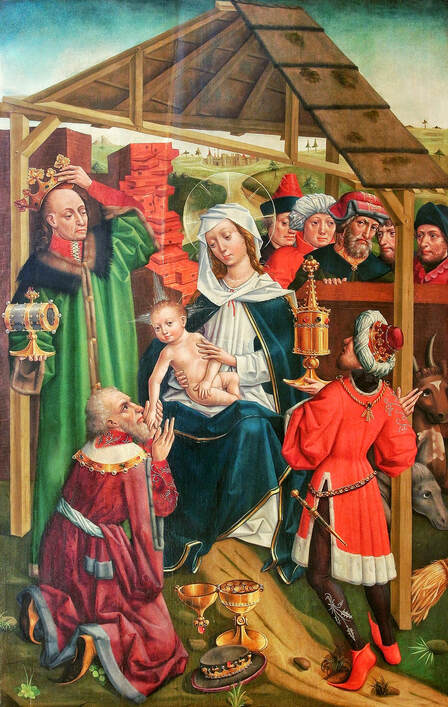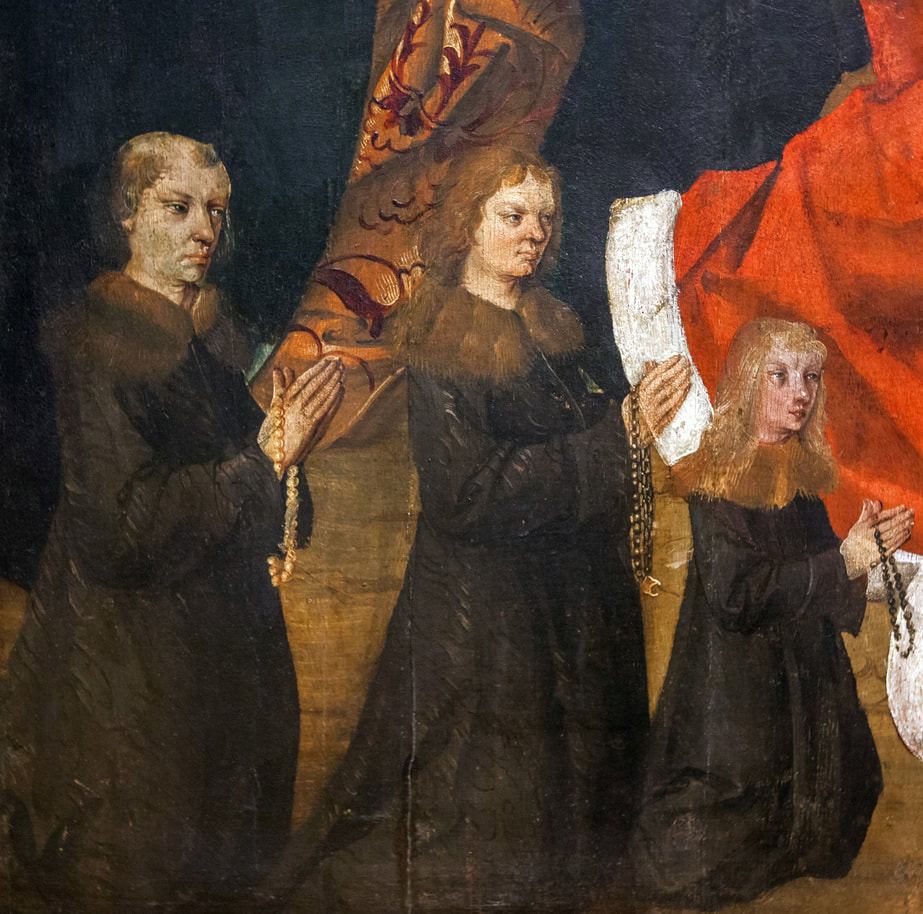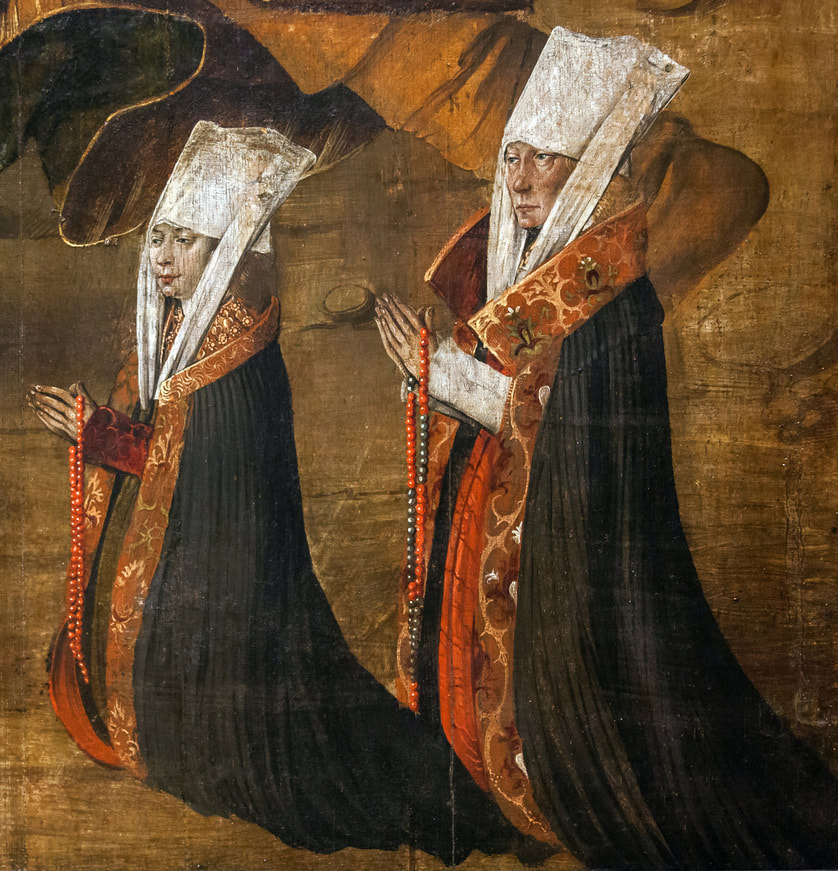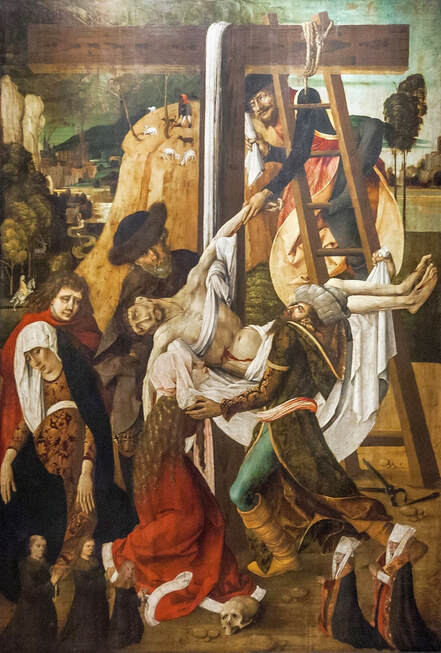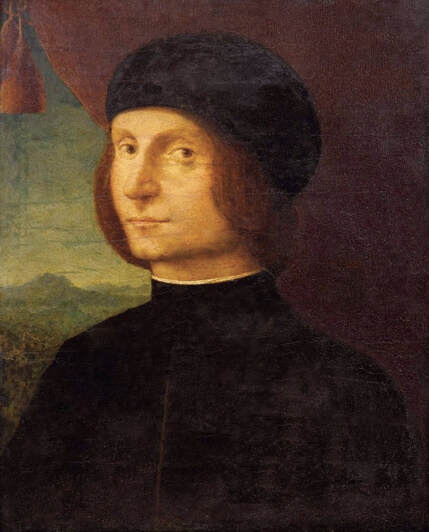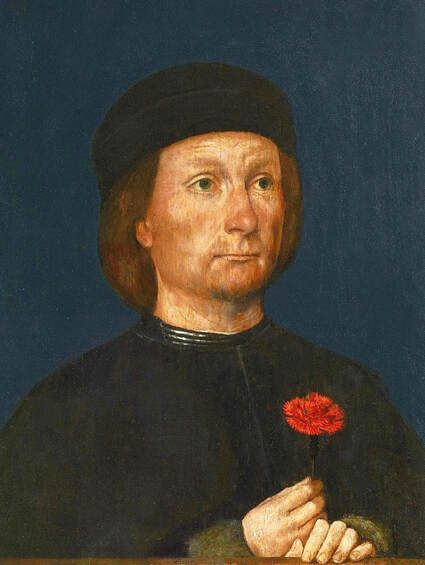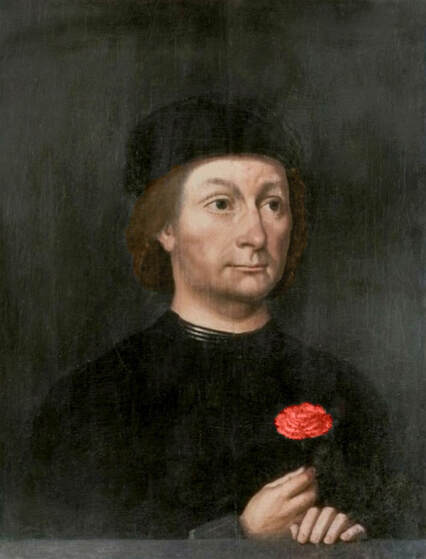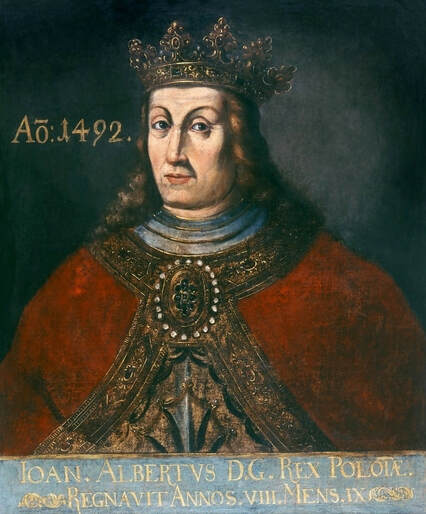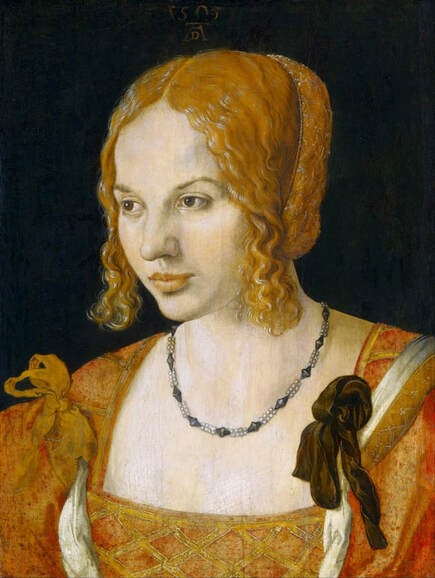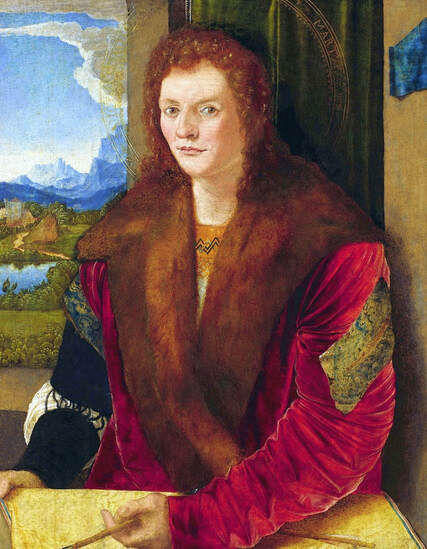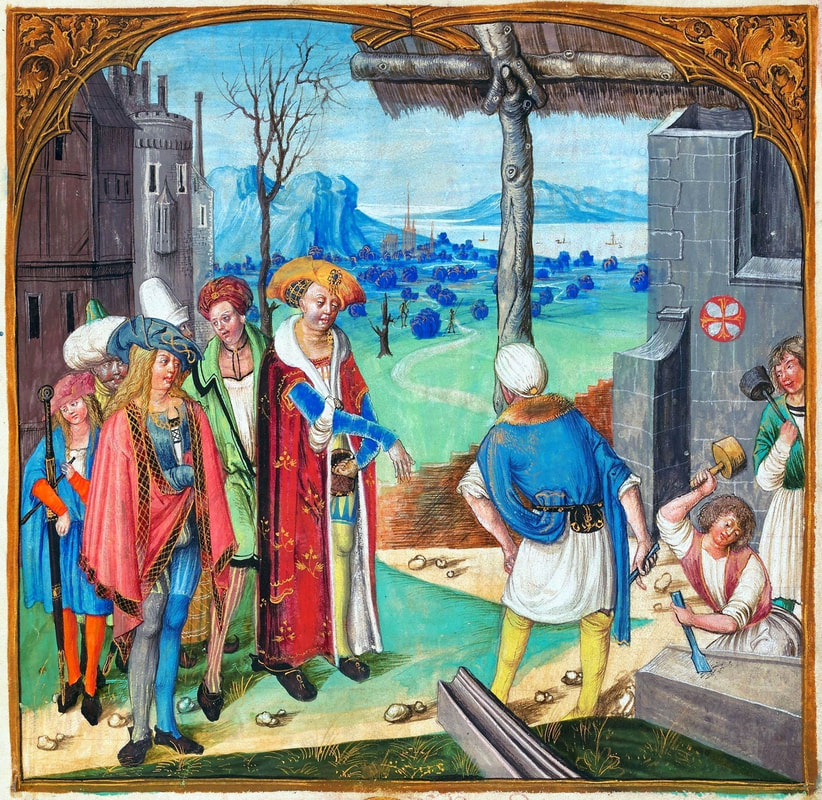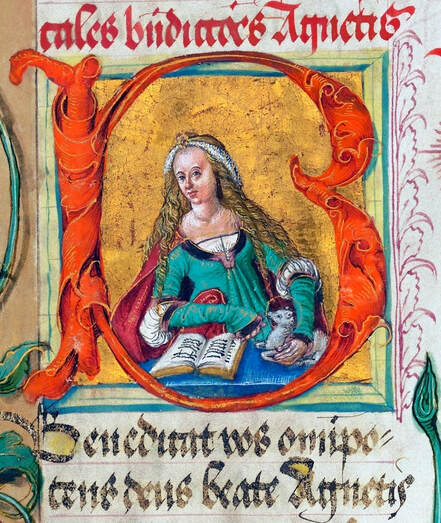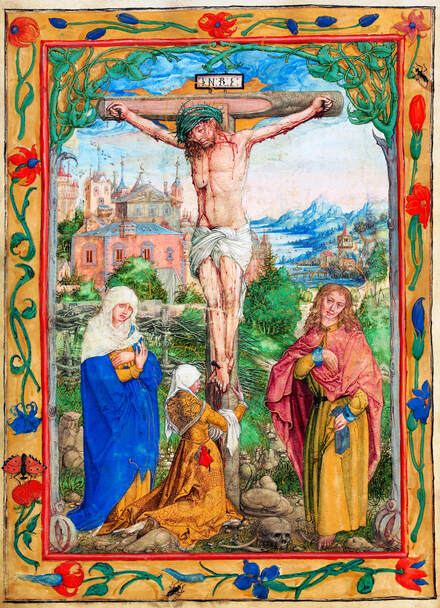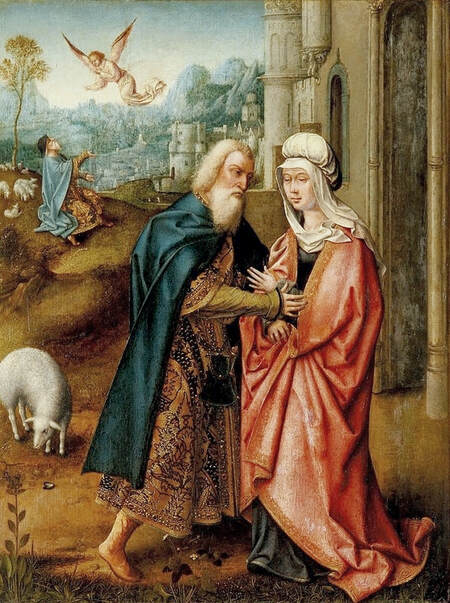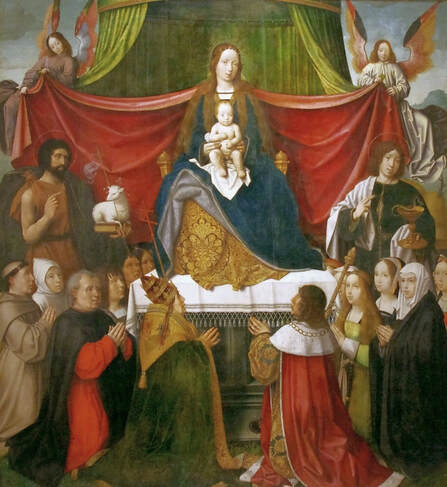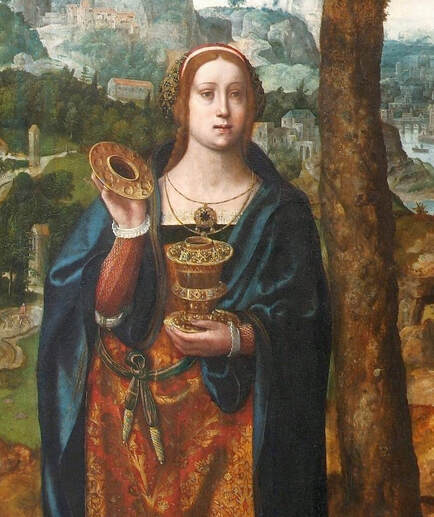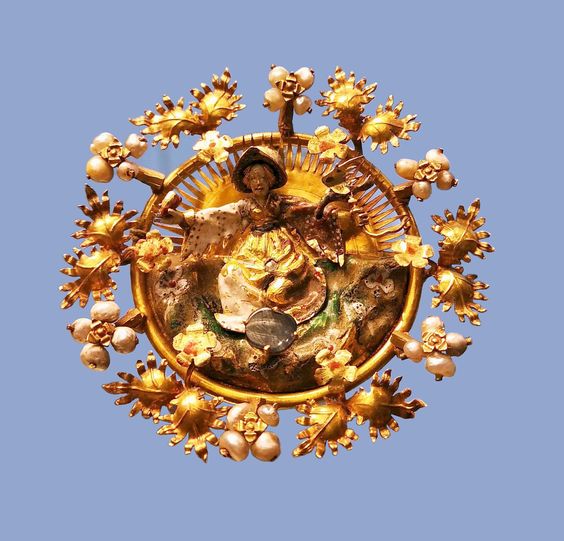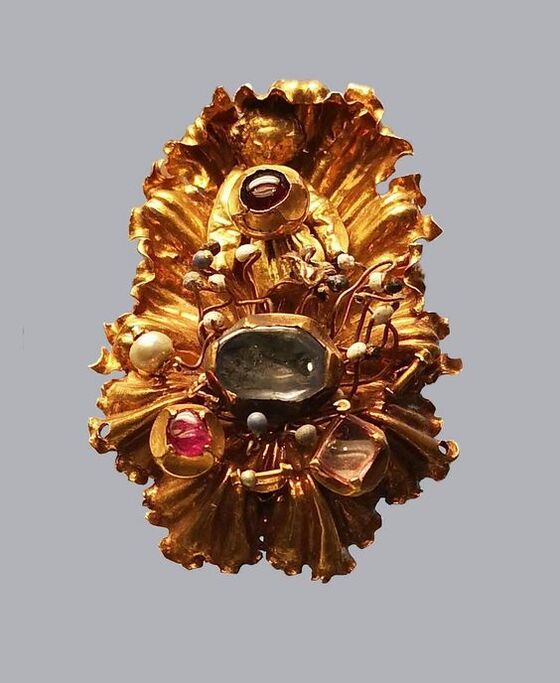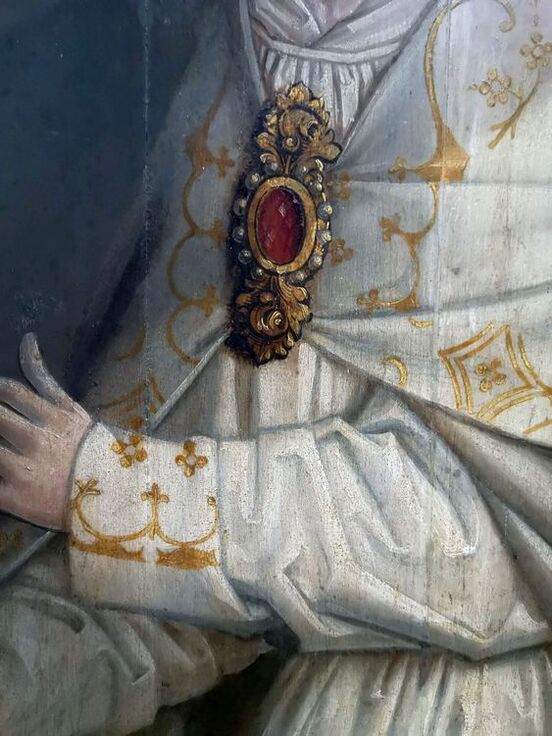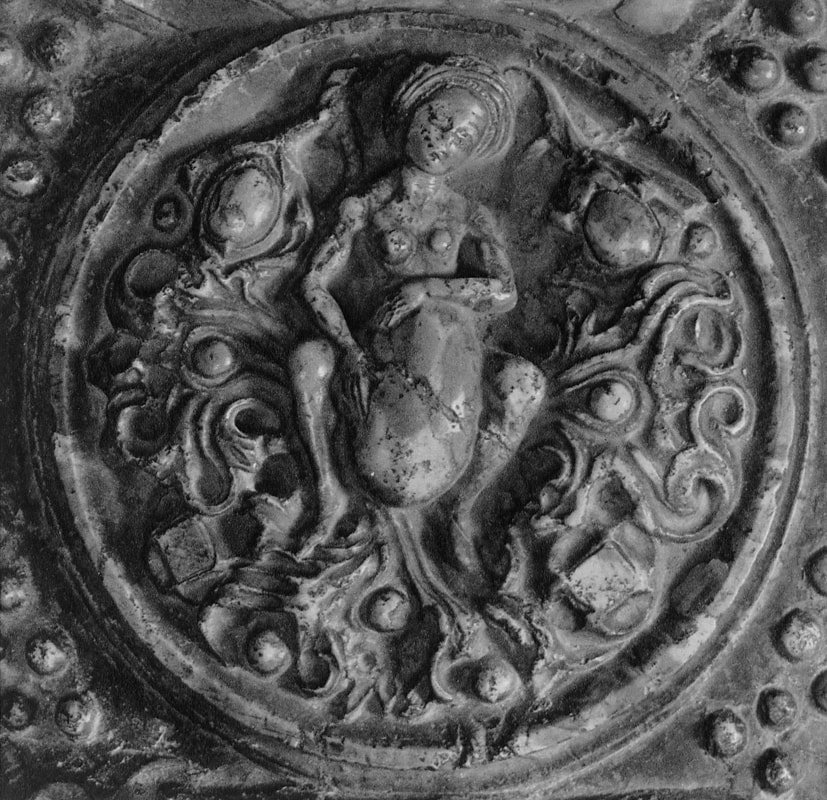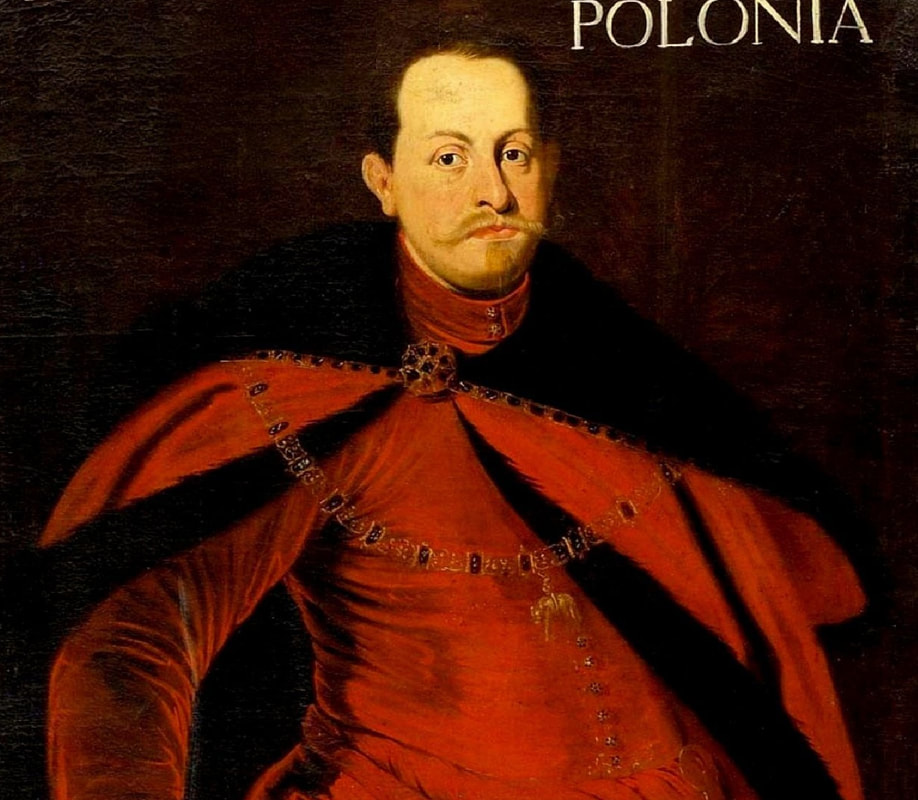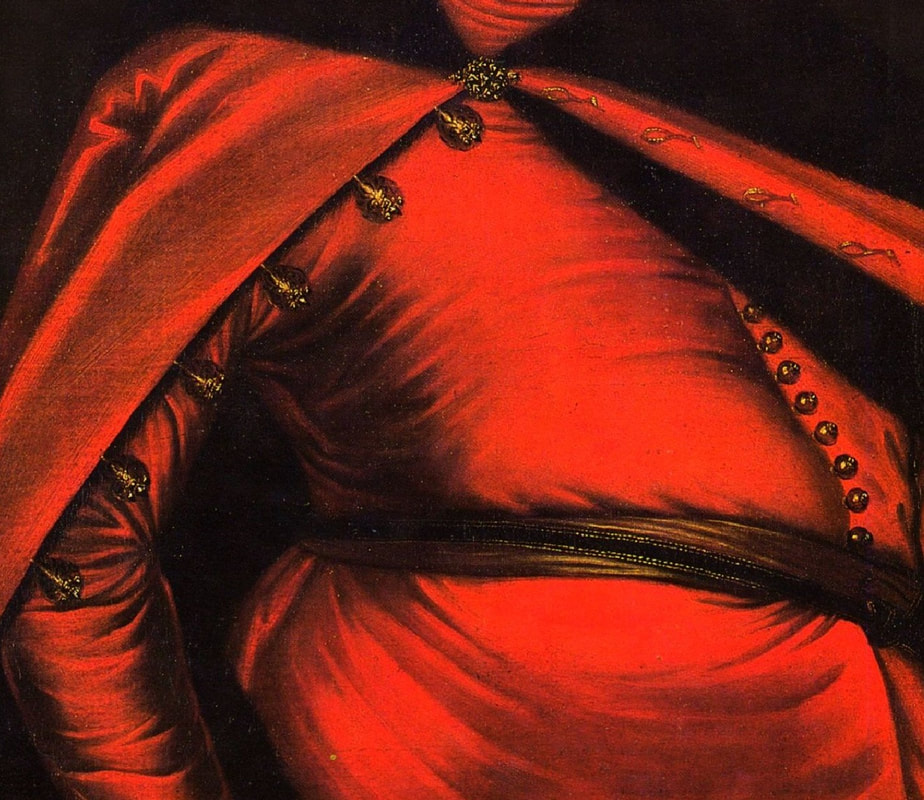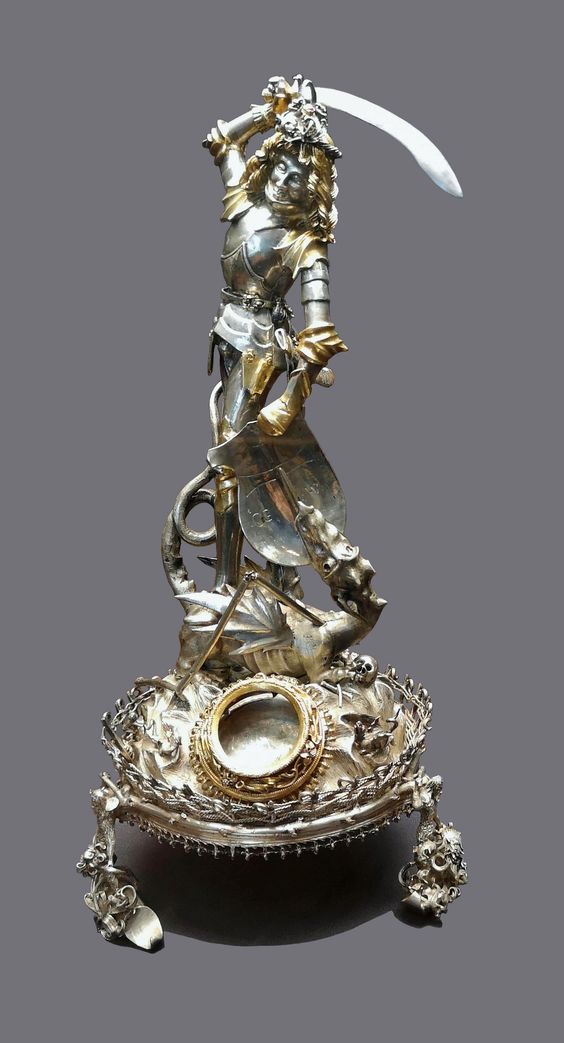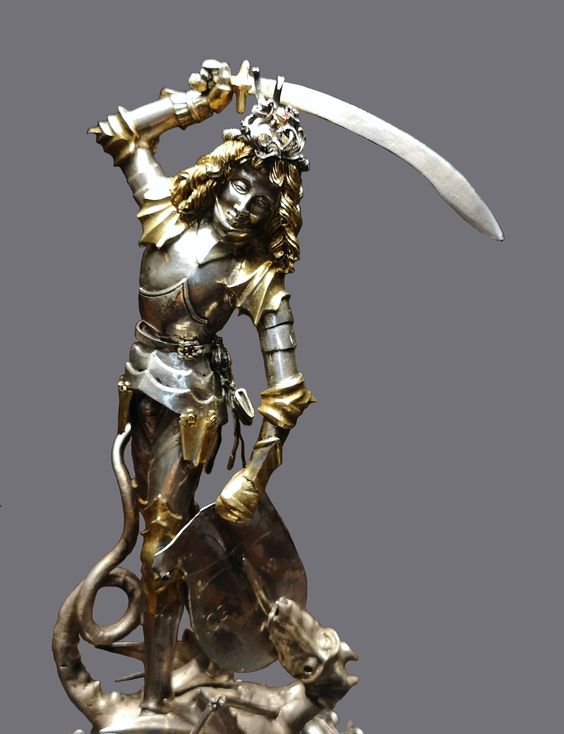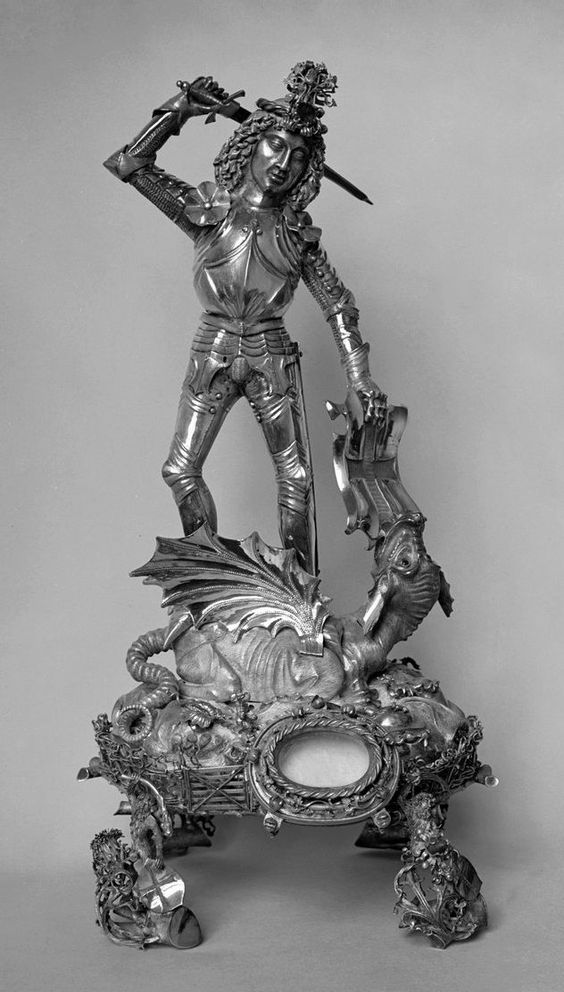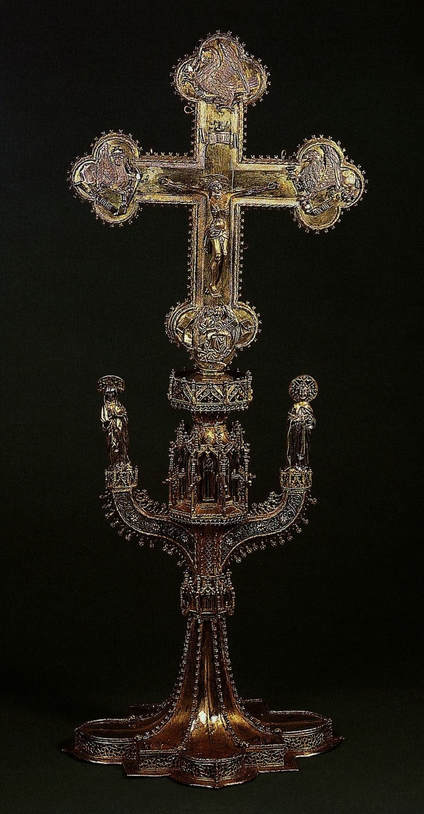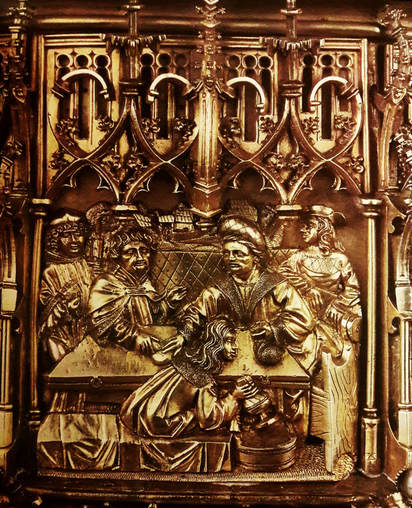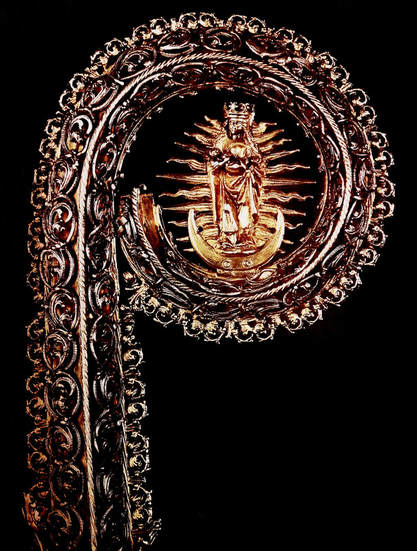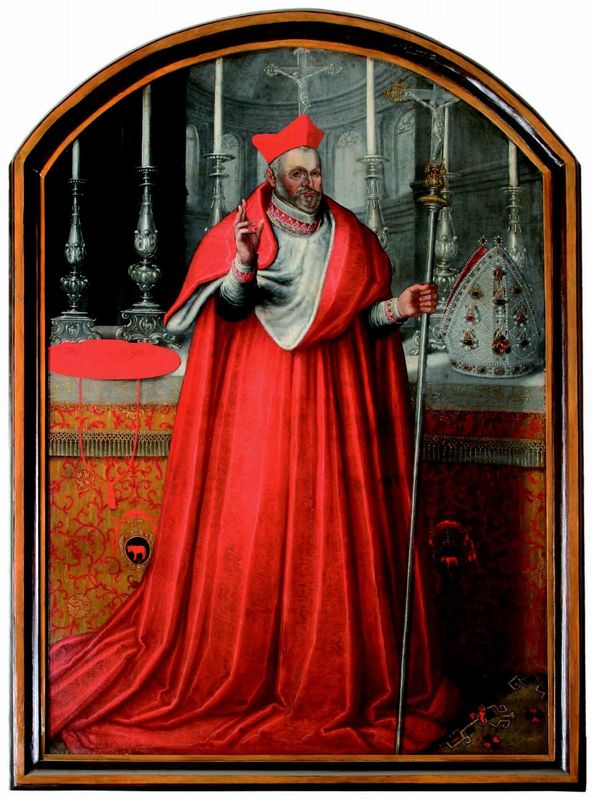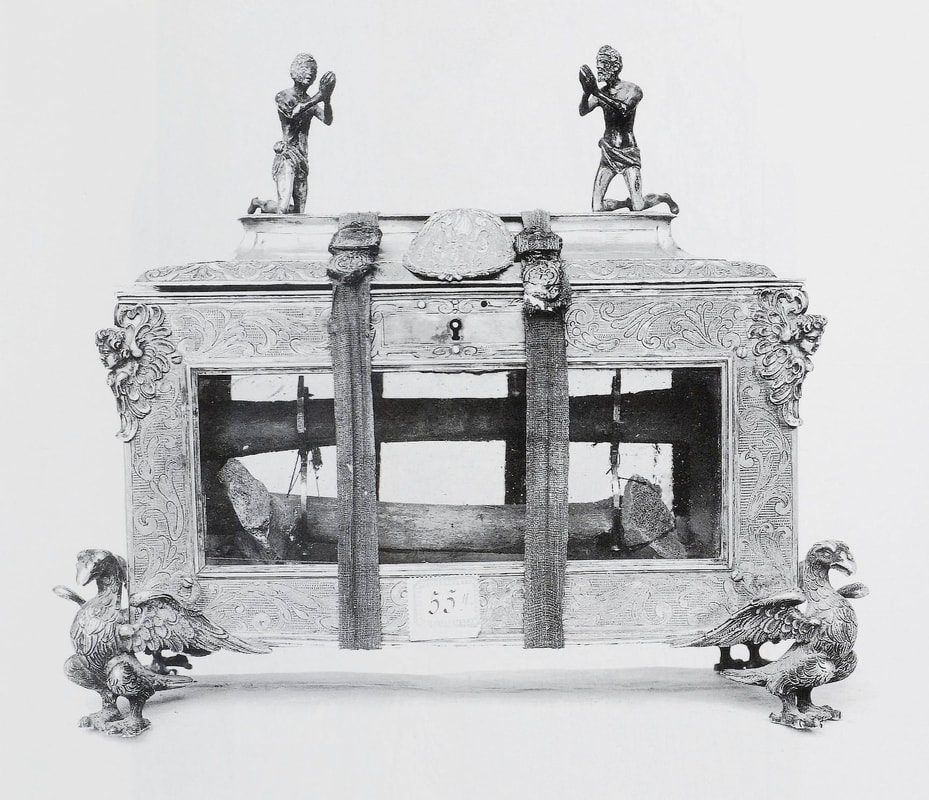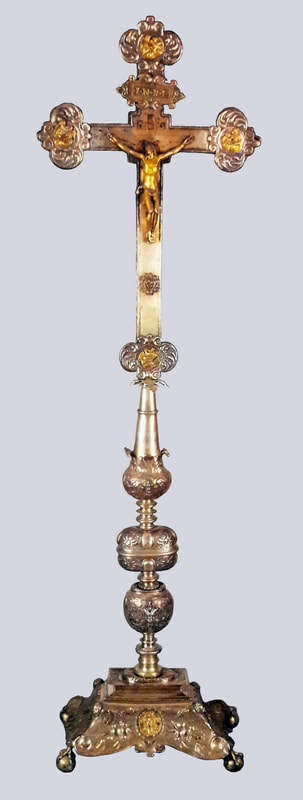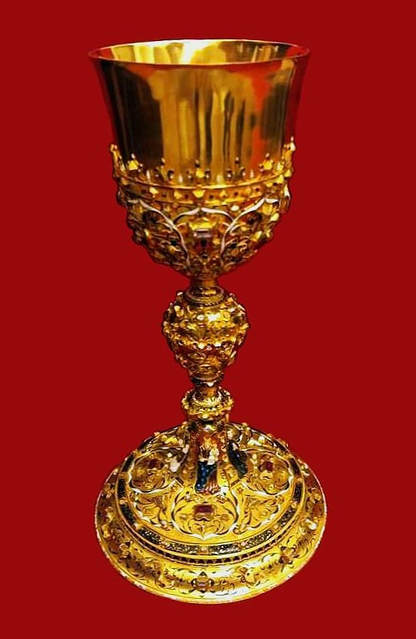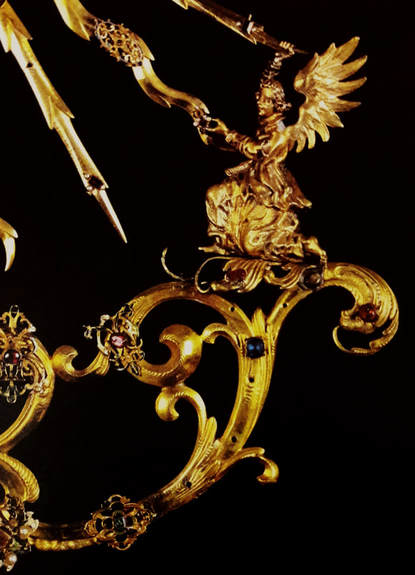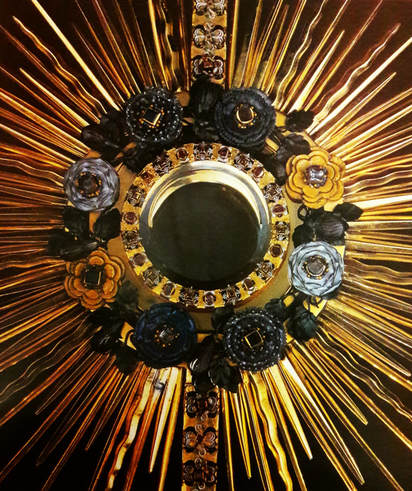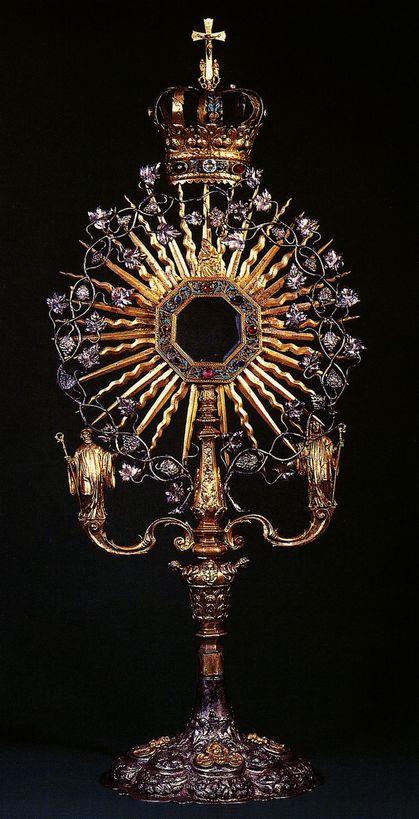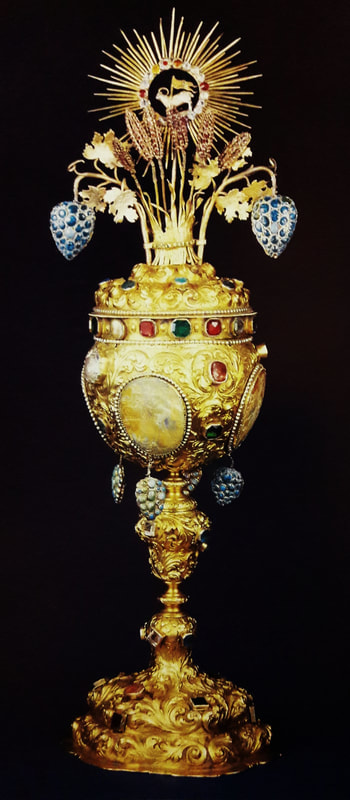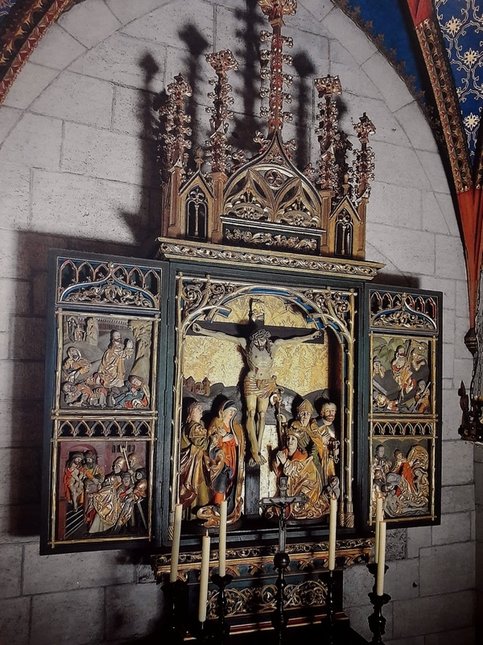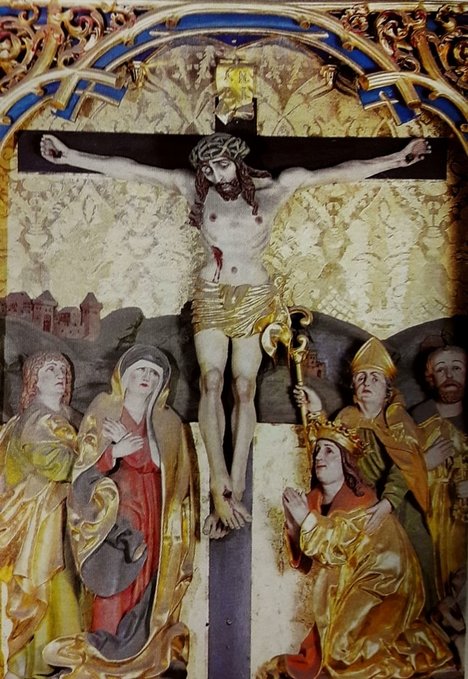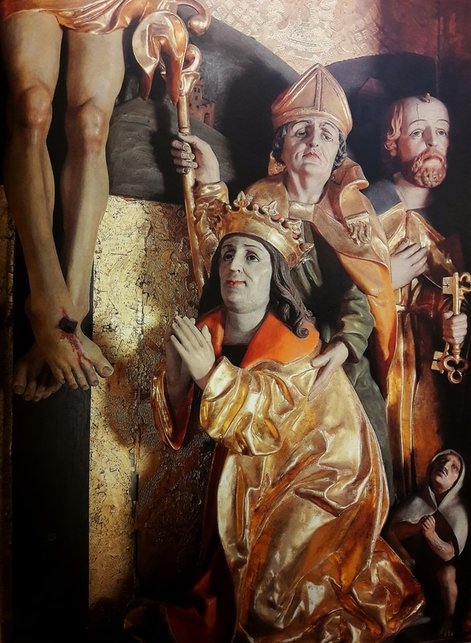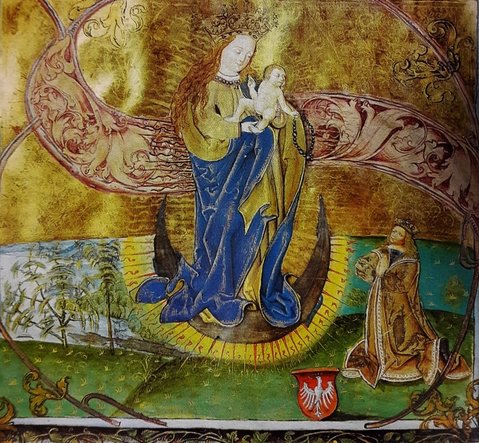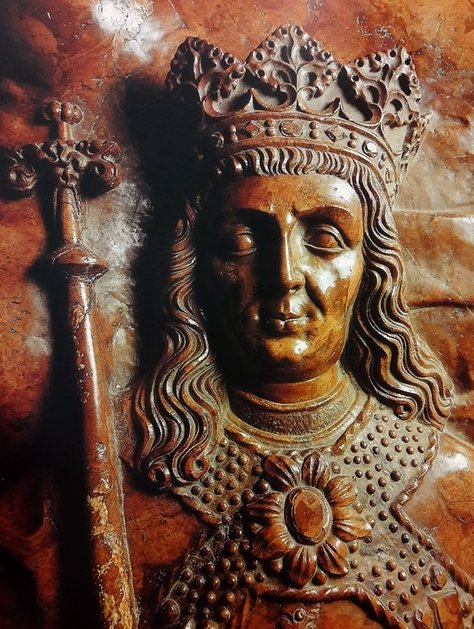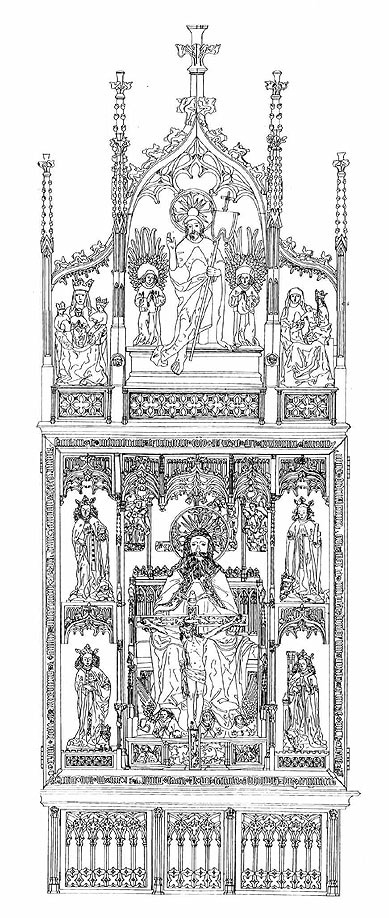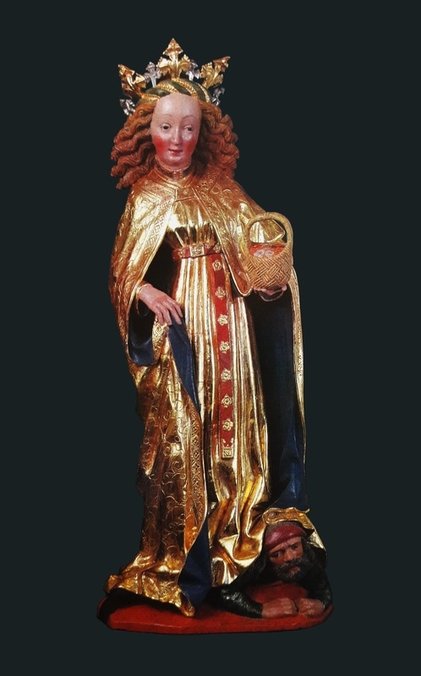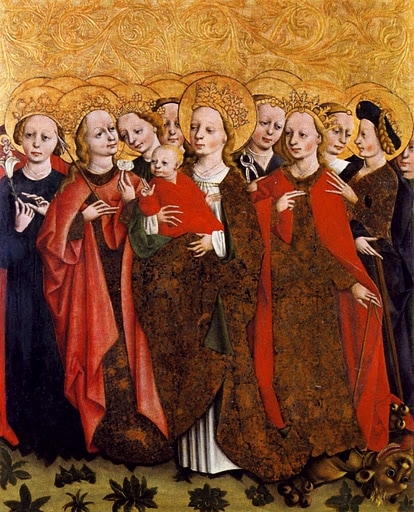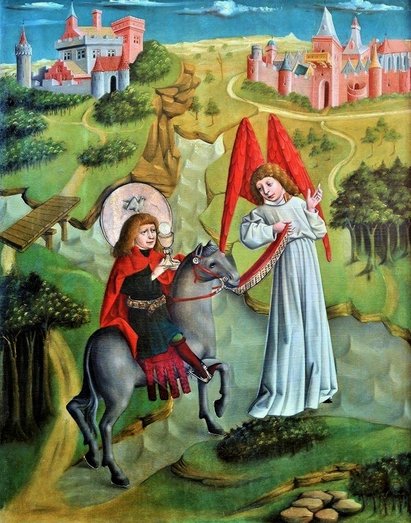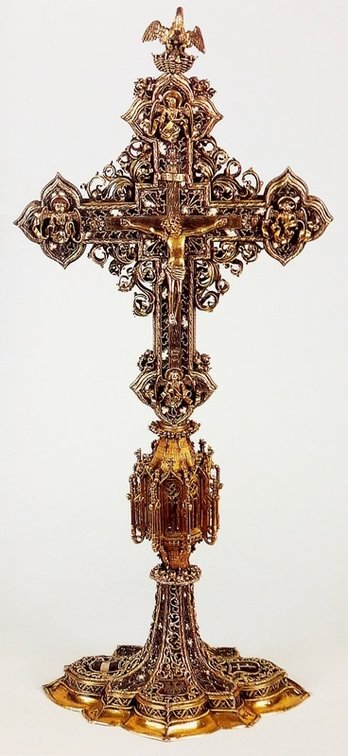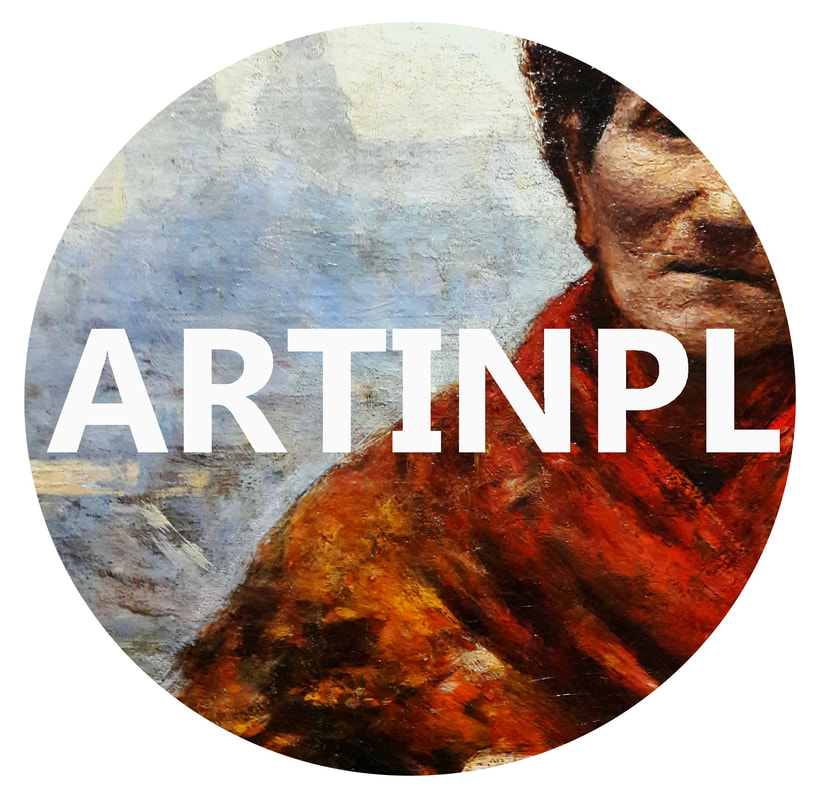|
Adoration of the Magi with portraits of Elizabeth of Austria, Casimir IV Jagiellon and Jogaila of Lithuania by Stanisław Durink
The portrait of King Ladislaus II Jagiello (Jogaila of Lithuania) as one of the Biblical Magi, venerated as saints in the Catholic Church, in the scene of the Adoration of the Magi is one of the oldest effigies of the first monarch of the united Poland-Lithuania. The painting is a section of the Our Lady of Sorrows Triptych in the Holy Cross Chapel (also known as the Jagiellon Chapel) at the Wawel Cathedral, which was built between 1467-1477 as a burial chapel for King Casimir IV Jagiellon (1427-1492) and his wife Elizabeth of Austria (1436-1505) - lower section, reverse of the right wing.
The triptych is considered the foundation of Queen Elizabeth mourning the death of her son Casimir Jagiellon (1458-1484), future Saint - her coat of arms, of the Habsburg family, as well as the Polish eagle and Lithuanian knight are in the lower part of the frame. The text of the Stabat Mater anthem on the frame could also indicate this (after "Malarstwo polskie: Gotyk, renesans, wczesny manieryzm" by Michał Walicki, p. 313). It is because of the great and unmistakable resemblance to the king's effigy on his tombstone in the same cathedral, the context and European tradition that one of the Magi is identified as a portrait of Jogaila. He was also depicted as one of the scholars in the scene of the Christ among the doctors in the same triptych. Consequently, the other two Magi are identified as effigies of other Polish rulers - Casimir the Great and Louis of Hungary. The other men in the background could be courtiers, including the painter's self-portrait (the man in the center, looking at the viewer), according to the well-known European tradition. Paintings in this triptych are attributed to Stanisław Durink (Durynk, Doring, Durniik, Durnijk, During, Dozinlk, Durimk), "painter and illuminator of king Casimir of Poland" (pictor et, illuminaitor Casimiri regnis Poloniae), as he is called in the documents of 1451, 1462 and 1463, born in Kraków (Stanislai Durimk de Cracovia). Durink was a son of Petrus Gleywiczer alias Olsleger, an oil merchant from Gliwice in Silesia. He died childless before 26 January 1492. If the majority of these effigies are disguised portraits of real people, why not the Madonna? This effigy seems too general, however, there are two important features that are not visible at first glance - the protruding lower lip of the Habsburgs and Dukes of Masovia and the depiction of the eyes, similar to the portrait of Queen Elizabeth, presumed founder of the triptych, in Vienna (Kunsthistorisches Museum, GG 4648). Therefore Melchior, the oldest member of the Magi, traditionally called the King of Persia, who brought the gift of gold to Jesus, is not Casimir the Great, but Casimir IV Jagiellon, Elizabeth's husband and the son of Jogaila. His effigy can also be compared to the counterpart of the portrait of Elizabeth in Vienna (GG 4649), which, like the Queen's portrait, was based on the depiction of the couple from the Family Tree of Emperor Maximilian I by Konrad Doll, painted in 1497 (Kunsthistorisches Museum in Vienna, reproduced in a lithograph by Joseph Lanzedelly from 1820). Casimir IV was depicted with a longer beard in a print in Theatrum virorum eruditione singulari clarorum by Paul Freher (Berlin State Library), published in 1688 in Nuremberg. The last monarch (Louis of Hungary on the right) was depicted from behind, so it is less likely to be a "disguised portrait". The purpose of these informal portraits was ideological - to legitimize the dynastic rule of the Jagiellons in the elective monarchy, a reminder that despite their rule is dependent on the will of the magnates, their power was bestowed on them by God. The Roman Catholic Chapel of the Holy Cross was decorated with Russo-Bizantine frescoes created by Pskov painters in 1470, so its ideological program was dressed for followers of the two main religions of Poland-Lithuania: Greek and Roman. Byzantine Patriarchal cross became the symbol of Jagiellonian dynasty (Cross of Jagiellons) and reliquary of the True Cross (Vera Crux) of Byzantine emperor Manuel I Komnenos (1118-1180), given to Jogaila in 1420 by emperor Manuel II Palaiologos (1350-1425), was a coronation cross of the Polish monarchs (today in the Notre-Dame de Paris - Croix Palatine).
Adoration of the Magi with portraits of Elizabeth of Austria as Madonna and Casimir IV Jagiellon and Jogaila of Lithuania as the Magi by Stanisław Durink, ca. 1484, Wawel Cathedral.
Portrait of Queen Elizabeth of Austria by Giovanni Bellini
"A large painting from His Majesty King Casimir in a box. Sub letter R. This image is of the Blessed Virgin, the Lord Jesus standing in front of her on a table covered with a carpet, there is a jug with flowers and behind him a beautiful landscape" (Obraz niemały od Krola Je° Mći Kazimierza w Puzdrze. Sub litera R. Ten Obraz iest Nayswiętsza Panna Pan Jezus przed nią stoi na stole Kobiercem przykrytym, y Dzban z Kwiatami i zanim pękny Lanszawt), this is how the inventory of the collection of paintings belonging to the influential Helena Tekla Lubomirska née Ossolińska (1622-1687), written in Wiśnicz on January 28, 1678 after the death of her husband, describes the painting which was offered to her by the last Vasa on the Polish-Lithuanian throne John II Casimir (1609-1672), descendant of the Jagiellons (National Archives in Kraków, Sanguszko Archive, WAP nr 201, p. 28). Helena Tekla put her signature under this entry, indicating that the painting may have been given to her directly by the king, perhaps shortly after his abdication and before departure for France in 1668. The king took many of his possessions, including those he had inherited from his ancestors and which he managed to evacuate during the Deluge (1655-1660). Many of these belongings were later sold in Paris in 1673. He also offered paintings to different monasteries (several paintings were given to the Visitandines Monastery in Warsaw) and friends. The Lubomirska's painting was probably destroyed during the Great Northern War (1700-1721) or during the great fire of Wiśnicz Castle in 1831.
Nothing more is known about this painting, but the description indicates that it was an Italian painting from the turn of the 15th-16th centuries, since such depictions with a standing Child are the most typical of Italian Renaissance painting. A somewhat similar composition was painted by Pinturicchio in the late 15th century, now in the National Gallery, London (tempera on panel, 53.5 x 35.5 cm, NG703), decorated with the coats of arms of the patrons, but this painting is rather small. At that time, larger Madonnas were "produced" in Venice. For example, the Virgin and Child enthroned with an oriental carpet, made by Gentile Bellini around 1475-85, in the same collection, is much larger (oil on panel, 121.9 x 82.6 cm, NG3911), as well as the Madonna and Child blessing, painted in 1510 by his brother Giovanni, today at the Pinacoteca di Brera in Milan (oil on panel, 85 x 115 cm, inv. 298, signed lower left: IOANNES / BELLINVS / M D X). Given Poland-Lithuania's contacts with Venice during the Renaissance, as well as those with the Bellini workshops, it is quite possible that the painting offered by John Casimir was created in their workshop. When I saw for the first time in November 2023 the painting by Giovanni Bellini, acquired by Wawel Castle, Virgin and Child in front of a green curtain and a landscape (oil on panel, 74.6 x 57.3 cm, ZKnW-PZS 10475, signed lower center: IOANNES BELLINVS P), I was struck by the great resemblance of the woman represented as the Virgin to Queen Elizabeth of Austria (1436/7-1505), wife of Casimir IV Jagiellon (1427-1492). In the effigy we can see a similar shape of the nose and protruding lower lip as in the later copy of the queen's effigy in the Kunsthistorisches Museum in Vienna (GG 4648) and in the portrait of her son Sigismund I in Gołuchów Castle (Mo 2185). The painting was also exhibited at the Palace of the Grand Dukes of Lithuania in Vilnius in 2024. What a coincidence that one of the most important female monarchs of Central Europe returned to Poland and Lithuania after several centuries of oblivion. This painting has probably never been here before, although we cannot exclude that other versions were in Poland-Lithuania. The sad thing about all this is that I seem to be the only one who noticed it. It is difficult, though, to believe in resemblance and an intuition, when it is not explicitly confirmed in the sources or in the painting itself (inscription, coat of arms) and experts say that it is not a portrait. It should be noted, however, that the general context and symbols are enough to identify the models in the paintings, but when it comes to Poland-Lithuania, it seems that many researchers want to believe that it was an artistic desert, especially before 1655-1660 and as regards the royal heritage. In recent years, research has revealed that the National Gallery of Victoria's "Portrait of a young man" (inv. 1587-5), attributed to Dosso Dossi or his younger brother Battista, is not a man at all but Lucrezia Borgia (1480-1519), daughter of Pope Alexander VI, called by a Venetian chronicler Girolamo Priuli (1476-1547) "the greatest courtesan of Rome" (Lucrezia la piú gran cortigiana che fosse in Roma, after "Lucrezia Borgia: La sua vita e i suoi tempi" by Maria Bellonci, p. 124). It contains symbolic references to Venus and the ancient Roman heroine Lucretia. The oldest known provenience of the Wawel painting is the collection of Henry Woods (1822-1882) or his son William at Warnford Park, Hampshire (compare "De la propriété de la Fondation collection Château de Rohoncz", p. 14) or the Moroni collection in Milan (a copy?), reported in 1934 (Fototeca Zeri, Numero scheda 28285) and although it is not confirmed, such a splendid painting was most likely owned by important patrons, such as the Tudor dynasty in England or the Sforza family that ruled Milan when the painting was executed in the late 15th or early 16th century. Portraits were part of diplomacy since the beginnings of portraiture as a distinct domain (portraits sent to allies, potential brides or grooms, influential family members abroad etc.) and the contacts of Poland-Lithuania with the Kingdom of England and with the Duchy of Milan are very old. In 1469, Alexander Soltan, son of the Ruthenian Orthodox boyar from Lithuania, visited England. He was sent there as an envoy of Casimir IV. The purpose of his trip was political negotiations and King Edward IV presented him with a gold chain. In December 1468, before arriving in England, Soltan was at the court of Galeazzo Maria Sforza, Duke of Milan, who recommended him to other rulers in a special document. Nearly two decades earlier, on August 4, 1450, the English King Henry VI had granted Casimir the Order of the Garter. Nicolaus von Popplau (Mikołaj z Popielowa), described as a Silesian born in Wrocław, who visited England in 1484, as well as several other European countries in the years 1483-1485, stated that "the English also do not regret spending a lot on feasts and a comfortable life, but they are not equal in this respect to the Poles" (after "Mikołaj z Popielowa" by Xawery Liske, p. 6), which gives an idea of the material status of Poland-Lithuania at the end of the 15th century. While in England it is not difficult to find traces of the country's wealth, such as numerous portraits of the queens of England - Elizabeth Woodville (d. 1492) or Elizabeth of York (1466-1503), what happened to the heritage of Poland-Lithuania? The painting is compared to very similar composition painted by Giovanni Bellini in 1487 - Madonna of the Small Trees (Madonna degli alberetti), which takes its name from the two poplar trees standing symmetrically on the sides of the green curtain which forms the backdrop to the group of the Virgin and Child, now kept in the Gallerie dell'Accademia in Venice (oil on panel, 71 x 58 cm, inv. 596, signed lower center: IOANNES BELLI ... / 1487). The Madonna of the Small Trees was gifted with other works by the aristocrat Girolamo Contarini, a member of one of Venice's founding families, in 1838, so it had probably been in the city since its creation and perhaps represents a member of the Contarini family. Another Contarini - Ambrogio (1429-1499), left a description of the court of Casimir IV during his visit to Poland-Lithuania in 1474 and 1477. The painter used the same set of study drawings for both compositions (Madonna of the Small Trees and the Wawel painting), changing only a few elements. Besides the trees in the background - poplar in the Madonna of the Small Trees and perhaps a chestnut tree or an oak at the beginning of winter in the Wawel painting, which undoubtedly has an important symbolic meaning, color of the child's hair, he notably changed the face of the Madonna. The lips, nose and eyebrows are different - she's definitely a different woman. If the Madonna was not a portrait, why did the painter change the face of a woman? Especially to the image with less classic features? He already had a beautiful model for his Madonna of the Small Trees, why look for another?, especially for a painting which probably left Venice shortly after its creation (possibly sent as a diplomatic gift). Each Madonna should be unique and the majority of Bellini's Madonnas are unique. Patrons paid to have a unique image, which is another indication that Wawel painting was not intended for Venetian customers, otherwise two Venetian noble families would have very similar paintings representing two different women. The Bellini workshop was very popular, so the artist and his students had to work quickly to meet the number of orders. This, however, means that they must rely on the reuse of other compositions. In the Madonna and Child with Saint Paul and Saint George in the same gallery (Gallerie dell'Accademia, inv. 610), which comes from the collection of Count Bernardino Renier, member of another old Venetian family, offered in 1850, they borrowed some elements from the Madonna of the Small Trees, notably the woman's face. Disguised portraits or cryptoportraits (kryptoportrety), from the Greek word kryptós meaning hidden, concealed, have been known in Polish literature on the subject since at least the mid-20th century and among the best known is the portrait of Jogaila of Lithuania (King Ladislaus II Jagiello) as one of the Biblical Magi in the triptych of Our Lady of Sorrows (Wawel Cathedral), the portrait of his descendant King Sigismund I as one of the Three Kings in the prayer book of the Chancellor of Lithuania Albertus Gastold/Vaitiekus Gostautas (University Library in Munich) or the Mystical marriage of Saint Catherine with the disguised portrait of Katarzyna Franciszka Denhoffowa née von Bessen (d. 1695), mistress of King John II Casimir Vasa, represented as Saint Catherine of Alexandria (compare "Dzieje sztuki polskiej ..." by Janusz Kębłowski, p. 143). Such representations have origins in ancient times (e.g. the sculptural self-portrait of Phidias on the shield of Athena Parthenos, as described by Plutarch, which depicts him naked in battle against the Amazons) and they often had additional meaning. One of Giovanni Bellini's best-known portraits - the portrait of Fra Teodoro of Urbino in the National Gallery, London (on loan from the Victoria and Albert Museum, L1115), painted in 1515 (M D XV), is in fact a disguised portrait. It represents the monk of the Dominican monastery of San Zanipolo, located not far from Bellini's workshop, with the attributes of Saint Dominic. More and more disguised portraits, many of which have been forgotten since the time of the Council of Trent (1545-1563), which indirectly prohibited such representations ("there be nothing seen that is disorderly, or that is unbecomingly or confusedly arranged, nothing that is profane, nothing indecorous", after "The Canons and Decrees ..." by James Waterworth, p. 236), are currently being rediscovered, such as the portrait of a lady as Saint Lucy by Giovanni Antonio Boltraffio, painted around 1509 (Museo Thyssen-Bornemisza, inv. 52 (1934.44)), portrait of a young woman as Saint Agatha by Giovanni Busi Cariani, painted between 1516-1517 (National Galleries Scotland, NG 2494) or portrait of a lady as Saint Agatha (probably Giulia Gonzaga), painted by Sebastiano del Piombo in Rome in the early 1530s (National Gallery, London, NG24), although the exact identity of many of these effigies still remains a mystery. "This painting, then, is not only a religious painting but also a portrait, bringing together in one canvas two categories of early modern image making that have long been understood as not only distinct but binarily opposed to each other", comments Adam Jasienski on the portrait of a woman in the guise of Saint Barbara from the first half of the 17th century (after "Praying to Portraits", p. 1-2). Church reformers could not openly prohibit such depictions, as this tradition largely concerned Europe's most powerful ruling dynasties, such as the Habsburgs and Medici. The woman with the jewelled headband, depicted as Madonna and Child, painted by Ercole de' Roberti, court painter of the Este family in Ferrara, between 1490-1496 (The Art Institute of Chicago, 1947.90), bears a strong resemblance to the effigies of Beatrice d Este (1475-1497), Duchess of Bari and Milan, who, on January 18, 1491, in Pavia, married Ludovico il Moro (1452-1508), regent of Milan. Some popes and other church officials also lent their features to images of saints (Pope Leo X as Saint Pope Leo I in the Meeting of Leo the Great and Attila by Raphael or the Supper of Saint Gregory the Great with portrait of Pope Clement VII by Giorgio Vasari). Many of these rediscovered disguised portraits can still be found in the temples for which they were painted or offered, such as Descent of Christ into Limbo with many contemporary portraits (Alessandro Allori as Isaac, Costanza da Sommaia as Judith), painted by Bronzino in 1552 (Medici Chapel at the Basilica of Santa Croce in Florence), Mystical marriage of Saint Catherine with the disguised portraits of counts of Silvano Pietra, painted by Lucrezia Quistelli della Mirandola in 1576 (Chiesa Santa Maria e San Pietro in Silvano Pietra, compare "In mostra a Milano la pala di Silvano Pietra" by Maurizio Ceriani), Adoration of the Magi with portraits of King Sigismund III Vasa, his son Prince Ladislaus Sigismund and their courtiers from the second quarter of the 17th century (Church of St. Nicholas and St. Lawrence in Dłużec near Olkusz, compare "W asystencji, w przebraniu ..." by Jacek Żukowski, p. 21) or mentioned triptych of Our Lady of Sorrows (Holy Cross Chapel at the Wawel Cathedral). Certain works by Giovanni Bellini, his workshop, his entourage or followers are present in different collections of the former Poland-Lithuania. A painting by Bellini is also linked to the Jagiellons - Lamentation of Christ, painted after 1475, which was located before the Second World War in the Kaunas Cathedral (oil? on wood, 90 x 74 cm). This painting was probably donated by King Alexander Jagiellon (1461-1506), son of Elizabeth of Austria, in 1503, and mentioned in the 1522 inventory of the Kaunas parish church made by Canon Joannes Albinus (Imago Depositionis de Cruce Domini Jesu Christi in assere, erecta a quo et quamdiu in hac ecclesia est, non constat, solum varij sexus hominum linguis et testimonijs fertur ab 80 plus minus annis in liac parochiali ecclesia existere ..., after "Viešpaties Jėzaus Kristaus apraudojimo ..." by Laima Šinkūnaitė, p. 156-158). While it should be noted that the Kaunas painting was a version of a painting generally attributed to the Florentine school (Davide Ghirlandaio and Bastiano Mainardi), the compositions were nevertheless frequently copied at that time by different painters, especially if they contained disguised portraits. In Kaunas there is also the Virgin and Child with Saint John the Baptist by the circle of Giovanni Bellini from the beginning of the 16th century (National Museum of Art, ČDM MŽ 1549) and in Kraków there is the Virgin with the Blessing Child by Giovanni Bellini from around 1480 (Czartoryski Museum, MNK XII-202). The latter painting comes from the Czartoryski collection and was mentioned in a register of paintings from their collection published in 1914 (compare "Galerja obrazów: katalog tymczasowy" by Henryk Ochenkowski, p. 37, item 158). The paiting was attributed to pupil of Giovanni Bellini, Niccolò Rondinelli (d. 1520), active mainly in Ravenna, similar to his composition in the Indianapolis Museum of Art (24.6) and repeating the Bellini's composition from Madonna and Child with St. John the Baptist and St. Anne or St. Elizabeth in Städel Museum (inv. 853) and another version from Fonte Avellana Monastery, now in the Galleria Nazionale delle Marche (inv. 643). Two similar Madonnas are in the Gemäldegalerie in Berlin (inv. III.126 and B.12). Earlier provenance has not been established, so an acquisition in the late 15th century and a provenance from the royal collection of Polish-Lithuania can be considered. The Holy Family from the collection of the architect Stanisław Zawadzki (1743-1806), today kept in the Church of Saint Catherine of Alexandria in Rzeczyca, is attributed to the circle of Giovanni Bellini (compare "Nieznane aspekty biografii architekta Stanisława Zawadzkiego" by Ryszard Mączyński, p. 72-73), but it is another version of a painting attributed to Francesco Bissolo, a student of Bellini, now kept in the Crema Cathedral. Aleksander Przezdziecki (1814-1871) provides some information on Queen Elizabeth's Italian connections in his article on the queen published in 1852. According to this author, Juan Andrés y Morell (1740-1817), director of the Royal Library of Naples, had a manuscript with the following title: Elisabeth Alberti secundi Imperatoris filia nupta Casimiro IV Poloniae Regi, Hungariae et Bohemiae haeres nata A. D. 1439, denata 1505, hanc institutionem conscripsit filio suo Wladislao Hungariae, Bohemiaeque Regi clarissimo ("Elizabeth, daughter of Albert the Second Emperor, married to Casimir IV, King of Poland, heiress of Hungary and Bohemia, born A. D. 1439, died in 1505, wrote this document to her son Wladislaus, the most serene king of Hungary and Bohemia"). The manuscript, written in beautiful and elegant Latin, had 140 pages and was acquired from the library of Pope Pius VI (1717-1799) by a citizen of Naples. In the former Habsburg collections in Vienna there is another manuscript under the title Helisabetha Poloniae Regina Wladislao Pannoniae, Воhemiaeque Regi, filio Carissimo S. P. D. De Institutione Regii Pueri, written by the queen (Austrian National Library, Cod. 10573). This small manuscript of 138 pages is decorated with a double coat of arms of Bohemia and Hungary on the first page and the crowned letters W and A (Wladislaus, Anna), undoubtedly belonging to Elizabeth's son King Vladislaus II Jagiellon (1456-1516), king of Bohemia, Hungary and Croatia. In this manuscript, written after September 1502 and before July 1503, before the expected childbirth of her daughter-in-law, Vladislas's second wife, Anne of Foix-Candale (1484-1506), Queen Elizabeth sends her son advice on the upbringing of the child, whom she calls a son and calls by her favorite name - Casimir. However, her premonition was wrong, because instead of a son, a daughter, Anna Jagiellonica, was born (July 23, 1503). The queen advises her eldest son: "Casimir, your father, congratulated himself and considered it a blessing that he had with him Callimachus [Filippo Buonaccorsi], the Italian poet, who taught you and your other brothers Latin literature" and "Casimir, your father, praised the custom of the Italians, who used to eat three or at most four kinds of dishes and add water to their wine; and he did not attribute this moderation in life to stinginess, as many people understand, but to temperance, the most beautiful virtue and care for health". She also adds that "Alexander, also your brother and the invincible King of Poland, who recently gave a certain young man as many pieces of gold and a beautiful horse for twenty-four poems published in his praise, shines with a similar generosity" and that "Often, in my presence, Callimachus told of a cardinal who was killed in the night by his bedchamber servant, simply because he never looked at him with a cheerful eye". "If Casimir and Albert [King John I Albert (1459-1501)] had not treated Callimachus generously and graciously, I don't think any memory of them would have come down to posterity. And you, if you despise the wisdom of scholars, consider what will happen to you after death!", she further praises the court poet (who commissioned portraits in Venice) basing the fame of her husband and son on his activities. She also mentions the Venetian diplomat Sebastiano Giustiniani (1460-1543), who was ambassador to the court of Vladislas for three years: "a learned and prudent man, I heard that he praises your seriousness in a strange way" and advises that the boy should learn Italian and German, in addition to Polish, French and Hungarian. The predominance of Italian and Venetian influences in this single document is astonishing. The queen also references ancient mythology, heroes and poets, such as Venus and her son Cupid, Artemis (Diana), Aeneas, Alexander the Great and Homer (p. 15 and 18 of the original manuscript), among others. Przezdziecki, praising the style of the manuscript and its "foreign elegance", speculates that it was not the queen herself who was the author, but her courtiers, supposedly one of the Florentines or other Italians, companions of Callimachus, many of whom were at the court of the Polish kings of the time, such as Arnolfo Tedaldi, to whom Callimachus dedicated his "Elegies of Love", Collenuccio da Pesaro, Ottaviano Calvani di Gucci, who wrote a letter in Italian on the death of Callimachus and Bernardino Galli, author of verses on Callimachus' tombstone. He also describes the wealth of the court of Casimir IV Jagiellon and the richness of the costumes, that in 1487 Elizabeth had a satin dress embroidered with pearls (Vestem ex athlassio et margaritis) and that Jakub Dembiński (1427-1490), chancellor in 1469, ordered from Florence silk fabrics for King Casimir, woven with gold, as evidenced by his letter to Lorenzo de' Medici, preserved in the Medici archives in Florence (after "O królowej Elżbiecie żonie Kazimierza Jagiellończyka ...", p. 524-527, 536, 543-547). Elizabeth was born in Vienna in 1436 or 1437 as the daughter of Duke Albert V of Austria (1397-1439), later king of Bohemia, Hungary and Croatia and king of the Romans from his union with Elizabeth of Luxembourg (1409-1442), the daughter of Emperor Sigismund (1368-1437). After death of their parents Elizabeth and her brother Ladislaus the Posthumous (1440-1457) were raised in the court of Frederick III (1415-1493), son of Cymburgis of Masovia (d. 1429). Frederick's secretary, Enea Silvio Piccolomini (1405-1464), future Pope Pius II, had an impact on their education and mentioned Juvenal, a Roman poet and author of the collection of satirical poems, as one of the authors for the young Ladislaus to study. Her marriage to Casimir was happy, although when he first saw Elizabeth he did not want to marry her. The queen also exercised some political influence. She gave birth to 13 children to her husband and thus she is known as the Mother of the Jagiellons and the Mother of Kings (Elizabeth regina Polonia mater plurium regum), because four of her sons became kings and Elizabeth's daughters, through their marriages, were associated with important ruling dynasties. Among the few artistic foundations of Queen Elizabeth that have been preserved, we can count the finest examples of late 15th and early 16th century art, such as the late Gothic tombstone of Casimir IV Jagiellon by Veit Stoss and Jörg Huber, made between 1492-1496, and the gold reliquary for the head of Saint Stanislaus by Marcin Marciniec, made in 1504, as well as the tombstone of King John Albert, created by Jörg Huber around 1502 and the niche sculpted by Francesco Fiorentino between 1502 and 1505, considered the first fully Renaissance work in Poland, all in Wawel Cathedral. In January 1504, Wojciech Krypa from Szamotuły (d. 1507), who had obtained his doctorate in Padua a year earlier, was appointed by King Alexander as his mother's physician (Albertus de Schamothuli, physicus regine Polonie Elizabeth). Based on examination of her skeleton discovered in 1972, scientists concluded that the queen suffered from a spinal abnormality, as well as a deformed skull and protruding teeth. Her known effigies confirm that an important feature of her face was prognathism, visible in the miniature in Vienna, in a woodcut from the so-called Łaski's Statute (Commune incliti Poloniae Regni privilegium ...), published in Kraków in 1506 and showing her as a progenitor of the Jagiellons, engraving with her portrait (Elisabetha, Imperatoris Alberti II filia, Casimiri Jagellonidis Uxor), made by the Flemish engraver Gilliam van der Gouwen in 1684 after an original from the second half of the 15th century (National Library of Poland, G.9796), representing her in a costume typical of European fashion of the time, and in a portrait taken from the family tree of Emperor Maximilian I, lithograph from 1820 by Joseph Lanzedelly after the original painting from 1497 by Konrad Doll (Austrian National Library). Protruding lower lip is also a feature visible in effigies of Elizabeth's father, Albert V. The queen undoubtedly gave her features to the Madonna in the scene of the Adoration of the Magi from the triptych of Our Lady of Sorrows in the Holy Cross Chapel (Wawel Cathedral), painted by Stanisław Durink around 1484. Facial expression with partially closed eyes looking down, resembles Bellini's painting. The Virgin from the Annunciation scene in the mentioned triptych is also strikingly similar. It is also worth noting a great resemblance to the features of Elizabeth's mother in a miniature from the same series in Vienna. The conclusion of a Latin poem written in her honor by an Italian poet, included by Elizabeth in her De Institutione Regii Pueri, also fits perfectly as a conclusion and summary for the description of this disguised portrait: "No mortal person receives such fame, such honors, You must be a Goddess!" (Non capit has laudes, non tot mortalis honores, / De superis aliquam te decet esse Deam!). Certainly, it was not only in poems that the great queen was a divine being.
Annunciation with disguised portrait of Queen Elizabeth of Austria (1436/7-1505) by Stanisław Durink, ca. 1484, Wawel Cathedral.
Portrait of Queen Elizabeth of Austria (1436/7-1505), the "Mother of Kings" (Mater Regum), as Madonna and Child in front of a green curtain and a landscape by Giovanni Bellini, after 1487, Wawel Royal Castle.
Family of Nicolaus Copernicus as donors by Michel Sittow
In 1484 Michel Sittow (ca. 1469-1525), a painter born in the Hanseatic city of Reval in Livonia (now Tallinn in Estonia) moved to Bruges in the Low Countries, at that time a leading economic center of Europe where painting workshops flourished. It is thought that he worked as an apprentice in the workshop of Hans Memling till 1488 and that he traveled to Italy. When in Bruges Sittow undoubtedly had the opportunity to meet Mikołaj Polak (Claeys Polains), a painter from Poland, who in 1485 was sued by the Bruges Guild of Saint Luke for using inferior Polish lazurite.
From 1492 Sittow worked in Toledo for Queen Isabella I of Castile as a court painter. He left Spain in 1502 and was presumably working in Flanders for Joanna of Castile and her husband Philip the Handsome. Michel probably visited London between 1503-1505, although this trip is not documented. Several portraits of English monarchs attributed to him could also have been made in Flanders on the basis of drawings sent from London. In 1506 the painter returned to Reval, where he joined the local guild of painters in 1507, and married in 1508. In 1514 he was called to Copenhagen to portray Christian II of Denmark. The portrait was intended to be a gift to Christian's fiancée, Isabella of Austria, a granddaughter of Isabella of Castile. From Denmark he traveled to Flanders, where he entered the service of Margaret of Austria, then regent of the Netherlands, and from there to Spain, where he returned to the service of Ferdinand II of Aragon, husband of Queen Isabella. When Ferdinand died in 1516, Sittow continued as court painter for his grandson Charles I, future Emperor Charles V. On an unknown date (between 1516 and 1518) Michel Sittow returned to Reval, where he married Dorothie, daughter of a merchant named Allunsze. In 1523, Sittow held the position of Aldermann (guild leader) and he died of plague in his hometown between December 20, 1525 and January 20, 1526. It is possible that between 1488-1492 Sittow returned to Tallinn. If he traveled by sea to or from Bruges or Spain, his possible stop was one of the largest seaports on the Baltic Sea - Gdańsk in Polish Prussia, the main port of Poland-Lithuania. If he traveled by land, he undoubtedly traveled through Polish Prussia and one of the biggest cities on the route from Bruges to Livonia - Toruń, where king Jagiello built a castle between 1424 and 1428 (Dybów Castle). One of the major works from this period in Toruń is a late Gothic painting depicting the Descent from the Cross with donors, today in the Diocesan Museum in Pelplin (tempera on oak panel, 214 x 146 cm, inventory number MDP/32/M, earlier 184984). It was earlier in the Toruń Cathedral and originally, probably, in the demolished church of St. Lawrence in Toruń or as the property of the Brotherhood of Corpus Christi at the Cathedral. The work was showcased during an international exhibition at the National Museum in Warsaw and the Royal Castle in Warsaw - "Europa Jagellonica 1386-1572" in 2012/2013, devoted to the period in which the "Jagiellonian dynasty was the dominant political and cultural force in this part of Europe". Many authors underline inspirations and influences of Netherlandish painting in this panel, especially by Rogier van der Weyden (after "Sztuka gotycka w Toruniu" by Juliusz Raczkowski, Krzysztof Budzowski, p. 58), the master of Memling, who had served his apprenticeship in his Brussels workshop. The landscape and technique can even bring to mind works by Giovanni Bellini (d. 1516), like Deposition (Gallerie dell'Accademia) and colors the works by Spanish masters of the late 15th century. It is known that in 1494 a Dutch painter named Johannes of Zeerug stayed at the court of king John I Albert. He could be the possible author of Sacra Conversazione with Saint Barbara and Saint Catherine and donors from Przyczyna Górna, created in 1496 (Archdiocesan Museum in Poznań). This painting was founded to the Parish church in Dębno near Nowe Miasto nad Wartą by Ambroży Pampowski of Poronia coat of arms (ca. 1444-1510), Starost General of Greater Poland, an important official close to the royal court, who was depicted as donor with his first wife Zofia Kot of Doliwa coat of arms (d. 1493). The style of the painting in Pelplin is different and resembles the works attributed to Michel Sittow - Portrait of a man with a pink - Callimachus (Getty Center), Portrait of King Christian II of Denmark (Statens Museum for Kunst), Madonna and Child (Gemäldegalerie in Berlin) and Portrait of Diego de Guevara (National Gallery of Art in Washington). He was also the only known artist of this level from this part of Europe, educated in the Netherlands, to whom the work can be attributed. The Descent from the Cross in Pelplin was a part of a triptych. However, the two other panels were created much later in different workshops. Basing on style and costumes these two other paintings are attributed to local workshop under Netherlandish and Westphalian influences and dated to around 1500. All three paintings were transferred to the Museum in Pelplin in 1928 and the central panel showing the Christ crowned with thorns was lost during World War II. The left wing representing Flagellation of Christ is now back in the Toruń Cathedral. This painting has almost identical dimensions as the Descent from the Cross (tempera on oak panel, 213 x 147 cm) and one of the soldiers tormenting Jesus has a royal monogram under crown embroidered with pearls on his chest. This intertwined monogram can be read as IARP (Ioannes Albertus Rex Poloniae), i.e. John I Albert, King of Poland from 1492 to his death in 1501. The founder of this painting depicted as kneeling donor in the right corner of the panel was therefore closely connected with the royal court. This man bears a striking resemblance to known likenesses of the most famous man from Toruń - Nicolaus Copernicus (born on 19 February 1473), who was baptized in the Toruń Cathedral. Some authors consider it to be an authentic image of the astronomer (after "Utworzenie Kociewskiego Centrum Kultury", 29.06.2022) founded by him in his lifetime. If the donor from the Flagellation painting is Copernicus, therefore the donors from the earlier Descent from the Cross should be his parents and siblings. Nicolaus' father, also Nicolaus was a wealthy merchant from Kraków, son of John. He was born around 1420. There is much debate as to whether he was German or Polish, perhaps he was just a typical representative of the Jagiellonian multiculturalism. He moved to Toruń before 1458 and before 1448 he traded in Slovak copper, which was transported by the Vistula to Gdańsk and then exported to other countries. In 1461, he granted a loan to the city of Toruń to fight against the Teutonic Order. Copernicus the Elder married Barbara Watzenrode, sister of Lucas Watzenrode (1447-1512), Prince-Bishop of Warmia, who studied in Kraków, Cologne and Bologna. The couple had four children, Andreas, Barbara, Catharina and Nicolaus. Copernicus the father died in 1483 and his wife, who died after 1495, founded him a portrait epitaph, known today only from a copy, on which we can see a man with a mustache, with folded hands in prayer, with similar features to his son. This copy was commissioned in about 1618 by astronomer Jan Brożek (Ioannes Broscius) for the Kraków Academy and it was repainted around 1873 (Jagiellonian University Museum, oil on canvas, 60 x 47 cm). The father of astronomer died at the age of about 63, while depicted man in much younger, therefore the original epithaph was probably based on some earlier effigy. The facial features of a man from the Descent from the Cross are very similar. Elongated face with wider cheekbones of the woman from the painting is similar to effigies of Barbara Watzenrode's brother Lucas and her famous son. As it was said Nicolaus the Elder died in 1483, while Sittow moved to the Netherlands in about 1484. Such a wealthy merchant or his widow could afford to order a painting from the artist, who at that time was possibly in Gdańsk or Toruń or even created in Bruges, when he settled there, and sent to Toruń. The appearance of younger of boys match the age of future astronomer, who was 10 when his father died. Barbara and Nicolaus had two daughters Barbara and Catharine, while on the painting there is only one. The elder Barbara, entered the convent in Chełmno, where she later became an abbess and died in 1517. It is generally believed that it was she who was mentioned in the list of nuns under the year 1450 there (after "Cystersi w społeczeństwie Europy Środkowej" by Andrzej Marek Wyrwa, Józef Dobosz, p. 114 and "Leksykon zakonnic polskich epoki przedrozbiorowej" by Małgorzata Borkowska, p. 287), therefore she "left" her family over 20 years before Nicolaus the astronomer was born. Apart from costly Polish azurite, painters in Bruges and other locations needed Copernicus' copper, which although is naturally green, "with the addition of ammonia (easily obtained from urine), it turns blue. The color became chemically stable if lime was added, and this chemistry process produced a cheap, bright blue that became an allpurpose paint for walls, wood, and books" (after "All Things Medieval" by Ruth A. Johnston, p. 551). In Gdańsk English and Dutch merchants purchased cenere azzurre, a blue pigment prepared from carbonate of copper (after "Original treatises dating from the XIIth to XVIIIth centuries on the arts of painting in oil ... ", p. cc - cci), similar to that visible in the Descent from the Cross in Pelplin.
Portrait of merchant Nicolaus Copernicus the Elder (d. 1483) and his two sons as donors from the Descent from the Cross by Michel Sittow, ca. 1483-1492, Diocesan Museum in Pelplin.
Portrait of Barbara Watzenrode and her daughter as donors from the Descent from the Cross by Michel Sittow, ca. 1483-1492, Diocesan Museum in Pelplin.
Descent from the Cross with family of Nicolaus Copernicus as donors by Michel Sittow, ca. 1483-1492, Diocesan Museum in Pelplin.
Portraits of Filippo Buonaccorsi, called Callimachus by Michel Sittow and workshop of Giovanni Bellini
"A face brighter than Venus' and the hair of Phoebus Apollo ... [more striking] than the stone polished by Phidias or the paintings of Apelles", this is how Philippus Callimachus Experiens (1437-1496) describes in his poem the beauty of the young clergyman Lucio Fazini Maffei Fosforo (Lucidus Fosforus, d. 1503), who became bishop of Segni near Rome in 1481. He advises elsewhere an elderly man: "Although the reverence of a wrinkled brow with white hair is esteemed ... Quintilius should prefer to be effeminate, so that he might always be ready for the prostitutes and the boys" (after "A Sudden Terror: The Plot to Murder the Pope in Renaissance Rome" by Anthony F. D'Elia, p. 96, 98).
Callimachus, humanist, writer and diplomat, was born Filippo Buonaccorsi de Tebadis Experiens in San Gimignano in Tuscany, in Italy. He moved to Rome in 1462 and he become a member of the Roman Academy of Giulio Pomponio Leto (Julius Pomponius Laetus, 1428-1498), who was later charged with sodomy, conspiracy against Pope Paul II and heresy. Filippo was accused of participating in the assassination attempt on the pope in 1468 and fled through southern Italy (Apulia-Sicily) to Greece (Crete-Cyprus-Chios) and Turkey, and then to Poland (1469/1470). The homo-erotic verses were discovered among his papers, including one dedicated to Fazini. The punishment for love between two men in Poland-Lithuania was similar as probably in most of the countries of Medieval/Renaissance Europe, nevertheless in Poland-Lithuania, like Rheticus almost a century later, he easly found powerful protectors, who undobtedly perfectly knew about his "inclinations". First he found work with the Bishop of Lviv, Gregory of Sanok (d. 1477), a professor at the Kraków Academy. Later he became tutor to the sons of the King of Poland Casimir IV Jagiellon and carried out various diplomatic missions. In 1474 he was appointed royal secretary, in 1476 he became ambassador to Constantinople and in 1486 he was the king's representative in Venice. With the accession to the throne of his former pupil John Albert, his power and influence reached its maximum. The envoy of the Republic of Venice, Signor Ambrogio Contarini (1429-1499), confirms the influences of Callimachus at the Polish-Lithuanian court: "On the 10th day (April 1474) I arrived in the land called Lublin. It is quite arable and has a decent castle where four of the king's sons stayed. [...] And they lived there in a castle with a very enlightened teacher who raised them. [...] One of them welcomed me with a short speech, as honorable and reasonable as one could ask for, and they showed extraordinary respect for their master". On his return from Persia, three years later, Contarini was again lavishly received by the king at Trakai in Lithuania and during the farewell, "the king charged me with greeting the most illustrious Signoria of Venice from His Majesty, and he added many kind words, and bade his sons speak to me in the same way" (after "Matka Jagiellonów" by Karol Szajnocha, p. 21, 23). In his writings, Buonaccorsi advocated the reinforcement of royal power. He also wrote poems and prose in Latin, although he is best known for his biographies of Bishop Zbigniew Oleśnicki, Bishop Gregory of Sanok, and King Ladislaus III Jagiellon. When in Poland, he also wrote love poems, many of which were addressed to his benefactress in Lviv with the name of Fannia Sventoka (Ad Fanniam Sventokam elegiacon carmen, In coronam sibi per Fanniam datam, In eum qui nive concreta collum Fanniae percusserat, De passere Fanniae, Narratio ad Fanniam de ejus errore, De gremio Fanniae, In picturam Fanniae, In reuma pro Fannia dolente oculos). This name is sometimes considered to be a pseudonym of Anna Ligęzina, daughter of Jan Feliks Tarnowski, or interpreted as Świętochna or Świętoszka (prude in Polish). The word Sventoka is also similar to Polish świntucha (rake, debauchee). Nevertheless, taking into consideration that some gay guys and transvestites like to use female nicknames, we cannot even be sure the "she" was indeed a woman. After the scandal in Rome, the poet had to be careful, fanatics could be anywhere. Almost two centries later, in 1647, transgender people were at the court of Crown Court Marshall Adam Kazanowski and Chancellor Jerzy Ossoliński. They were probably also at the royal court earlier. As a diplomat, Callimachus traveled a lot. His first stay in the royal city of Toruń is confirmed by his letter from this city to the Florentine merchant and banker Tommaso Portinari, dated June 4, 1474, regarding Hans Memling's altar "The Last Judgment", today in Gdańsk. In 1488 he settled for a few months, or maybe even longer, in the residence of bishop Piotr of Bnin, in Wolbórz near Piotrków and Łódź. That same year he went to Turkey and he took with him his young servant or secretary Nicholo (or Nicholaus), whom he calls "Nicholaus, my inmate", possibly Nicolaus Copernicus. Callimachus was on July 3, 1490 in Toruń and he lived there between 1494-1496, although in 1495 he left for Vilnius, Lublin, and finally to Kraków, where he died on September 1, 1496. Shortly before his death, on February 5, 1496, he purchased two houses in Toruń from Henryk Snellenberg, one was adjacent to the house of Lucas Watzenrode the Elder, maternal grandfather of Nicolaus Copernicus (after "Urania nr 1/2014", Janusz Małłek, p. 51-52). During his extended stay in Venice in 1477 and 1486, Callimachus established relations with the most eminent politicians, scholars and artists, like Gentile Bellini (d. 1507) and his younger brother Giovanni (d. 1516), a highly sought-after portraitist, who most probably created his portrait (after "Studia renesansowe", Volume 1, p. 135). In Getty Center in Los Angeles there is a "Portrait of a man with a pink", attributed to Michel Sittow (oil on panel, 23.5 cm x 17.4 cm, inventory number 69.PB.9). This painting was before 1938 in different collections in Paris, France and it was formerly attributed to Hans Memling. The man is holding a red carnation, a symbol of pure love (after "Signs & Symbols in Christian Art" by George Ferguson, p. 29). Clear inspiration of Venetian painting is visible in composition, especially by works of Giovanni Bellini (blue background, wooden parapet). The man's black costume, cap and hairstyle are also very Venetian, similar to that visible in Giovanni's self-portrait in the Capitoline Museums in Rome. The self-portrait shows Giovanni as a young man, hence it should be dated to about 1460, as it is generally belived that he was born in about 1430. The costume and apperence of a man from the portrait in Los Angeles also resemble that in bronze epitaph of Filippo Buonaccorsi, called Callimachus, created after 1496 by workshop of Hermann Vischer the Younger in Nuremberg to design by Veit Stoss (Basilica of Holy Trinity in Kraków). An exact copy of the Los Angeles portrait, attributed to Hans Memling or follower, is in the Czartoryski Museum in Kraków (oil on panel, 24.5 x 19 cm, inventory number V. 192). It was mentioned in a catalogue of the Museum from 1914 by Henryk Ochenkowski (Galerja obrazów: katalog tymczasowy) under the number 110 among other paintings by Italian school and a portrait of a man by school of Giovanni Bellini (oil on panel, 41 x 26.5 cm, item 4). The same catalogue catalogue also lists under number 158 a painting of Madonna and Child sitting before a curtain, which today is attributed to follower of Giovanni Bellini, and dated to about 1480 (Czartoryski Museum, inventory number MNK XII-202). The same man, although younger, was depicted in a painting attributed to Italian school, sold in Rudolstadt in Germany (oil on panel, 36 x 29 cm, Auktionshaus Wendl, October 29, 2022). His outfit, cap and hairstyle closely resemble those seen on the bronze medal with bust of Giovanni Bellini, created by Vittore Gambello and dated to about 1470/1480. The man stands in front of a curtain, which gives a view of a mountainous landscape. Inscription in English on verso on old adhesive label "The Portrait of Antonio Lanfranco ... at Palermo by J. Bellini", seems unreliable, because Jacopo Bellini, the father of Bellini brothers, died in about 1470 and no such inhabitant of Palermo who might have commissioned his portrait in Venice is mentioned in the sources. The style of this painting is close to workshop of Giovanni Bellini. It is highly possible that portrait of King John I Albert, Callimachus' pupil, commissioned by Toruń City Council to the Royal Chamber of the City Hall around 1645, which follows the same Venetian/Netherlandish pattern, was based on a lost original by Giovanni Bellini or Michel Sittow, created around 1492. If the author of inscription in English acquired the painting in Palermo, Sicily, then the mountin depicted in the background could be Mount Etna (Mongibello), an active volcano on the east coast of Sicily between the cities of Messina and Catania. In Quattrocento verse the hellishly boiling Mongibello was symbol of the vain torments of love and the insane fires of passion (after "Strong Words ..." by Lauro Martines, p. 135). The man's costume is also very similar to that seen in the portraits by Antonello da Messina (d. 1479), a painter from Messina, from the 1470s (Louvre Museum, MI 693 and Thyssen-Bornemisza Museum, 18 (1964.7)). "I said: It's a joke, he pretends to love [...] I believe that you burn not only with the dim, weak, gentle flame of love. But as much violent fire Has ever accumulated on earth, So much of it burns in you with all its might, Or how many islands of the Tyrrhenian Sea and Sicily, famous for their volcanoes Exploding fire, brought here From the depths and locked in you" (Dicebam: Iocus est, amare fingit [...] Flammis et placido tepere amore / Credam, sed rapidi quod ignis usquam / In terris fuerat simul cohactum / In te viribus extuare cunctis / Aut incendivomo inclitas camino / Tyreni ac Siculi insulas profundi), writes Callimachus about his torments in his poem "To Gregory of Sanok" (Ad Gregorium Sanoceum, ad eundem) (after "Antologia poezji polsko-łacińskiej: 1470-1543", Antonina Jelicz, Kazimiera Jeżewska, p. 59).
Portrait of Filippo Buonaccorsi, called Callimachus (1437-1496) by workshop of Giovanni Bellini, ca. 1477 or after, Private collection.
Portrait of Filippo Buonaccorsi, called Callimachus (1437-1496) holding a red carnation by Michel Sittow, ca. 1488-1492, Getty Center.
Portrait of Filippo Buonaccorsi, called Callimachus (1437-1496) holding a red carnation by workshop of Michel Sittow, ca. 1488-1492, Czartoryski Museum.
Portrait of John I Albert, King of Poland (1492-1501) in coronation robes by Toruń workshop, ca. 1645, Old Town City Hall in Toruń.
Portrait of Pope Alexander VI Borgia by the Vergós group and disguised portraits of Giulia Farnese by Pinturicchio
"Over the door of an apartment in the said palace he portrayed the Signora Giulia Farnese in the countenance of a Madonna, and, in the same picture, the head of Pope Alexander in a figure that is adoring her" (In detto palazzo ritrasse, sopra la porta d'una camera, la signora Giulia Farnese nel volto d'una Nostra Donna; e nel medesimo quadro, la testa d'esso papa Alessandro che l'adora), describes the fresco titled "The Divine Investiture" by Pinturicchio Giorgio Vasari (compare "Regesto dei documenti di Giulia Farnese" by Danilo Romei, Patrizia Rosini, p. 357 and "Le vite de' più eccellenti pittori, scultori e architetti" by Giorgio Vasari, Volume 5, National Library of Poland, 50.750, p. 269).
According to this description, published in 1568, this controversial fresco represented Giulia Farnese (1474-1524), mistress of Pope Alexander VI Borgia (1431-1503) and sister of Pope Pope Paul III Farnese (1468-1549), in the guise of the Madonna, in the scene of a intimate encounter of Pope Alexander and the Virgin Mary holding the Child Jesus. The Pope, kneeling before them, held the foot of the Child in his left hand, and little Jesus, holding a globus cruciger (cross-bearing orb), confirmed Alexander's authority in a gesture of blessing. Like other frescoes in the so-called Borgia Apartments of the Vatican Apostolic Palace, this one was also painted by Pinturicchio, painter active at the Vatican court under five popes, between 1491 and 1494 and the effigy of Borgia resembled his portrait in prayer in the fresco in the Room of the Mysteries of Faith (The Resurrection), kneeling at the feet of Christ. The pope wanted this family picture right in front of his bed where he could see it well, above the door that led to the dressing room. Upon his death, Julius II, does not want to sleep in the same bedroom with the work considered scandalous in front of his eyes. The new pope then commissioned Raphael to paint the upper rooms where he went to reside. The Borgia apartments were closed, no one could enter there except a very few absolutely trustworthy. Around 1612 the Duke of Mantua, Francesco IV Gonzaga (1586-1612), receives the news from his ambassador that the legendary fresco really exists and is hidden in the Vatican. After bribing a guardarobiere valet with a pair of silk stockings, his ambassador Aurelio Recordati manages to have the fresco, hidden with a piece of cloth, revealed and Pietro Facchetti, the painter and copyist, then makes a copy on canvas and sends it to Mantua. The Duke thus finds himself in the hands of a rather inconvenient testimony for the rival Farnese family, Dukes of Parma and Piacenza. Pope Alexander VII (1599-1667), after his inauguration, wanted to erase all traces of the infamous Borgia, in particular the much incriminated fresco, but his nephew prevented him from doing so. Rather than being destroyed, the work is removed by detaching the entire portion of the wall. The scene was divided into 3 parts, while the effigy of Alexander VI was certainly destroyed. The two parts, one with the Child Jesus and that of the Madonna, Chigi takes home to his personal collection at Palazzo Chigi, separated from each other by other works to disguise the recognition. And so it was for centuries, until in 1940 they were rediscovered in the Chigi collection and again after 2004 (compare "Il Bambin Gesù delle mani del Pinturicchio" by Isabella Ceccarelli). Giulia, a symbol of Renaissance beauty, that the populace called "the pope's concubine" (concubina papæ) or "the bride of Christ" (sponsa Christi) because of her well-known relationship with the pontiff, was married to Orsino Orsini, a relative of Alexander VI, on May 20, 1489, at the age of fifteen, in the palace of then Cardinal Rodrigo Borgia. The relationship between Giulia and Alexander VI could have been instrumental in the cardinal appointment for her brother, who later became pope under the name Paul III. The fresco in Borgia's bedroom was surely not the only effigy of Madonna Giulia Farnese (old Italian phrase ma donna means "my lady"). Researchers identify her effigies, or Vannozza Cattanei (1442-1518), chief mistress of Cardinal Borgia before he became pope, among the images of the Virgin in the Borgia Apartments, such as a tondo with the Virgin and Child with cherubim, scenes of Annunciation and Visitation. The effigy of Saint Catherine of Alexandria in the scene of the Dispute of Saint Catherine (Hall of the Saints) is considered to represent Pope Alexander VI's daughter Lucrezia Borgia (1480-1519), while the Mystical Marriage of Saint Catherine in the Vatican Museums (MV.40314.0.0) is most likely another disguised portrait of the pope's daughter as Saint Catherine and his mistress as the Virgin. Our Lady of the Fevers (Mare de Déu de les Febres) by Pinturicchio kept at the Museum of Fine Arts of Valencia (inv. 273), painted around 1495, should also be considered as Giulia's cryptoportrait. The painting was commissioned by Francisco de Borja (1441-1511), a relative of the pope, depicted as a donor kneeling before the Virgin and Child, to send to the family chapel of the collegiate church of Xativa in Spain, perhaps to celebrate his appointment as Bishop of Teano (Campania) in 1495. It includes the Borja/Borgia coat of arms with the typical bull (on a stool on which the Child stands), which is also a dominant motif of the Borgia Apartments. The painting was sent to Spain between 1497 and 1499 from Rome. Such disguised effigies, originating in antiquity, were certainly not a novelty in the Vatican. Many frescoes in the Borgia Apartments are directly inspired by the Roman statuary and one of the oldest mosaics from the St. Peter's Basilica - Mater Misericordie (Our Lady of Mercy) is most likely a disguised portrait of the Byzantine empress and wife of Emperor Justinian - Theodora (d. 548), a saint in the Eastern Orthodox Church, allegedly a former prostitute, known for her promiscuity. The mosaic comes from the Oratory of the Holy Door, built in 703 by Pope John VI, a Greek from Ephesus who reigned during the Byzantine Papacy (VETVSTA HÆC DEI GENITRICIS IMAGO, IN VATICANA BASILICA SVPRA PORTAM SCAM / ORATORIO OLIM A IOHANNE VII PONT-MAX SAL ANNO DCCIII CONSTRUCTO DIV SERVATA / ATQ. AD HVNC DIEM RELIGIOSISSIME CVLTA ...). It was removed in 1606, today in the Church of San Marco in Florence. The Madonna della Clemenza (Our Lady of Clemency), an encaustic painting on panel, in the Basilica of Santa Maria in Trastevere in Rome, possibly commissioned by the Greek-born Pope John VII, is another similar effigy. Pope Alexander VI was very active in European international relations. In a bull Inter cætera published on May 4, 1493, he divided the world outside Europe between Spain and Portugal by drawing a vertical line between the north and south poles. He encouraged the King of France in his plan to conquer Naples and even attempted to ally himself with the Ottoman Sultan Bayazid II. In Poland-Lithuania, the pope, known for his extremely promiscuous lifestyle and illegitimate children, ordered King Alexander Jagiellon (1461-1506) to confiscate the dowry and belongings of his wife Helena of Moscow (1476-1513), who refused to convert to Catholicism, and even "exclude her from the bed, home and any marital community" (compare "Jagiellonowie: leksykon biograficzny" by Małgorzata Duczmal, p. 254). Fortunately for the ruler, Erazm Ciołek obtained a rescission of Pope Alexander's orders to convert her from the next pope, Julius II, in August 1505. Such extensive international relations were undoubtedly accompanied by portraits. The counterparts were not only interested in the effigy of the pope, but also in the effigies of his family. Rodrigo Borgia undoubtedly had an interest in ensuring that the effigies were well distributed to his allies in Europe and Rome, as well as to members of his family and his entourage. A well-known portrait of Alexander VI in the Vatican Museums (oil and gold on panel, 40 x 29 cm, MV.40463.0.0) is a good example. The painting comes from the collection of Cardinal Stefano Borgia (1731-1804), member of the collateral branch of the House of Borgia of Velletri, so it was probably a family heirloom (since 1805 in the Congregation for the Evangelization of Peoples, n. 185). The style of this painting is clearly Spanish for the second half of the 15th century, it is thus conditionally attributed to a Spanish painter, whose stay in Italy is highly possible (and therefore the meeting with the pope) - Pedro Berruguete (d. 1504) or the Valencian School, as the pope was also Valencian (Valentinus - his epithet indicating his birth in the Kingdom of Valencia). It is speculated that Berruguete, a painter from the Kingdom of Castile, travelled to Italy in 1480 and worked in the court of Federico III da Montefeltro in Urbino, however he appears documented in Toledo in 1483, while the portrait of the pope can be dated between August 11, 1492 and August 18, 1503, the period of his pontificate. The style of the painting, with stucco reliefs and gold leaf in the background, is very similar to the painting kept in the National Art Museum of Catalonia in Barcelona depicting the Consecration of Saint Augustine, painted around 1463-1470/ 1475 (inv. 024140-000). This large painting, undoubtedly filled with several cryptoportraits of the local clergy, is attributed to the Catalan painter Jaume Huguet, who died between February 14, 1492, the date on which he made his will, and the month of May of the same year, when his wife is listed as a widow. The Consecration of Saint Augustine comes from the altarpiece of Saint Augustine, commissioned by the Guild of Tanners in 1463 from Jaume Huguet, but it was completed in 1486 and required the participation of several members of the Huguet workshop, as well as members of the Vergós group, to which another similar painting from this cycle is attributed - Saint Augustine disputing with the heretics (inv. 024141-000). Although it cannot be excluded that members of the Vergós group, such as Pau Vergós (died 1495), Rafael Vergós (died 1500) or Jaume Vergós (II) (died 1503), traveled to Italy during the pontificate of Alexander VI, it is more likely that they created the portrait in Barcelona based on other effigies, most likely by Pinturicchio. Battista Dossi or his circle (painted between 1535-1545, private collection) and Cristofano dell'Altissimo (second half of the 16th century, Uffizi Gallery, inv. 2989 - 1890), probably also based on the paintings of the Perugian painter creating their portraits of the pope. The question remains open as to why, having in his service a painter such as Pinturicchio, Borgia ordered his portrait (or portraits) abroad. Perhaps it was a gift from Barcelona, an advertisement of the Vergós workshop, or their fame prompted the Pope to order something in a different style, something more unusual or something from the country of his youth (in 1448 Rodrigo Borgia became canon of the cathedral chapters of Valencia, Barcelona and Segorbe, thanks to the influence of his uncle in Rome) and closer to his taste (glitter and abundance of gold in the decorations of the Borgia Apartments are attributed to the Hispano-Moorish taste of the Pope, compare "Pittori del Rinascimento: Pintoricchio" by Cristina Acidini, p. 192). Despite that, Pinturicchio and his workshop could not complain about the lack of work. In particular, they created numerous effigies of the Madonna, many of which closely resemble the "bride of Christ" from "The Divine Investiture", as if they were intentionally reusing the same face in different compositions. Some may argue that these compositions were not intended to depict Giulia, but the use of her features from the famous fresco indicates that they were in fact her cryptoportraits. We must keep in mind that since the time of Pope Julius II, effigies of Borgia and his family were subject to damnatio memoriæ and that many of these sometimes controversial effigies survived because people simply forgot that they were disguised portraits. While effigies of Alexander VI were easy to identify (and destroy) due to his characteristic features, the beautiful Madonna is only an effigy of the Virgin. We can identify the reuse of the same effigy in the Pinturicchio's Madonnas at the National Museum in Warsaw (tempera on panel, 45.5 x 37 cm, inv. M.Ob.4, earlier 5), Gemäldegalerie in Berlin (inv. 1481), Cleveland Museum of Art (inv. 1944.89), Isabella Stewart Gardner Museum (P15w35), Ashmolean Museum (WA1899.CDEF.P10), Fitzwilliam Museum (inv. 119) and others. The Warsaw Madonna is generally dated to around 1495 and is one of the first acquisitions of the Warsaw Museum of Fine Arts, purchased from the collection of Johann Peter Weyer (1794-1864) in Cologne in 1862, the year in which the museum was established (Partitioned Poland). Weyer, the city of Cologne's most notable architect, collected mainly paintings from the Germanic schools, which he undoubtedly acquired locally. Pinturicchio's painting could therefore come from the collection of Hermann IV of Hesse (1442-1508), archbishop-elector of Cologne from 1480 to 1508, who allied himself with Pope Alexander VI and thanks to whom he was elected bishop of Paderborn on March 7, 1498.
Portrait of Pope Alexander VI Borgia (1431-1503) by the Vergós group, ca. 1492, Paintings Gallery of the Vatican Museums.
Madonna bearing the features of Giulia Farnese (1474-1524), known as "the pope's concubine" (concubina papæ) or "the bride of Christ" (sponsa Christi), by Pinturicchio, ca. 1495, National Museum in Warsaw.
Portrait of Nicolaus Copernicus by Matthias Gerung after original by Giovanni Bellini or circle
Szto piszesz do nas o tot wschod, kotoryi esmo tam tobe u Wilni s palacu naszoho do sadu urobiti roskazali, comments in Belarusian (Old Ruthenian) the Italian-born Queen Bona Sforza on the alterations in the renaissance palace loggia in Vilnius, capital of Lithuania, to be made by Italian architect and sculptor Bernardo Zanobi de Gianottis, called Romanus in a letter of August 25, 1539 from Kraków in Poland (after "Królowa Bona ..." by Władysław Pociecha, p. 185). It is a perfect example of Polish-Lithuanian diversity in the 15th and 16th centuries.
Many material traces of this diversity and Polish-Italian connetions were lost. When the monarchs of Poland-Lithuania spoke and maintained chancelleries in different languages since the Middle Ages, the countries that partitioned the Polish-Lithuanian Commonwealth at the end of the 18th century, during the "Age of Enlightenment", tried to eradicate its culture and languages and all traces of its glorious past. Even today it is sometimes hard to believe that the great European artists and scientists could have had anything to do with poor and devastated Poland. Following Cicero's famous dictum "History is life's teacher" (Historia est magistra vitae) it is worth remembering controversial and painful facts, perhaps thanks to this they will not be repeated. According to some researchers, it was probably the young Nicolaus Copernicus (1473-1543) who accompanied Filippo Buonaccorsi, called Callimachus, tutor of king's sons and diplomat, on his mission to Turkey in 1488. He also sent him to Venice. Callimachus calls this boy "Nicholaus, my inmate" in a letter of May 15, 1488 from Piotrków to Lactantius Thedaldus (after "Urania nr 1/2014", Janusz Małłek, p. 51). From 1491 to 1494, Copernicus attended the University of Kraków with his brother Andreas and between 1496 and 1503 he studied in Italy, first in Bologna and from 1501 in Padua in the Venetian Republic. According to Jeremi Wasiutyński (1907-2005) it was him who was depicted in a portrait of a young man by Giorgione (Gemäldegalerie in Berlin, inventory number 12A). Nicolaus also travelled to other cities in Italy and Poland. In 1500 he left Bologna and spent some time in Rome on the occasion of the Holy Year, before returning to Frombork in 1501. He requested permission to extend his studies in Italy and that same year began studying medicine at the University of Padua. At the same time, he continued his law studies. During this time Copernicus was given the office of scholastic of the Church of the Holy Cross in Wrocław in Silesia, which he did not hold personally and he relinquished the sinecure in 1538. Copernicus and his brother Andreas, who had also received a study permit, also temporarily stayed with the curia in Rome as representatives of the Frombork cathedral chapter, it is however unclear whether Nicolaus was ever ordained a priest. Copernicus received his doctorate on May 31, 1503 at the University of Ferrara to become a Doctor of Canon Law (Doctor iuris canonici). Copernicus never married and is not known to have had children. Anna Schilling, a live-in housekeeper, is sometimes mentioned as his mistress, however, according to Copernicus' letter of December 2, 1538, she was "a related and honest housekeeper", i.e. his niece named Anna von den Schellings née Krüger (after "Anna Schilling nie była kochanką Mikołaja Kopernika" by Krzysztof Mikulski). It was most likely the young astronomer, who between 1492-1501 founded the painting of Flagellation of Christ, today in the Toruń Cathedral, where he was depicted as a kneeling donor. A soldier showing off his tight panties and buttocks just above his head, could be an allusion to his real "preferences". In 1554 Georg Joachim de Porris (1514-1574), also known as Rheticus, Nicolaus Copernicus's sole pupil, who was found guilty in his trial in absentia and consequently exiled from Leipzig for 101 years following the alleged drunken homosexual assault, relocated to Poland, where he continued his work within mathematics and astronomy, further compiling his calculations of trigonomic functions. Nicolaus undoubtedly also knew personally Callimachus, who wrote poetry with homosexual themes. The astronomer died at age 70 on 24 May 1543 in Frombork. Around 1580 the town physician and humanist, Melchior Pirnesius (1526-1589), who came to Toruń from Kraków founded an epitaph of Copernicus in the Toruń Cathedral. Later a portrait of King John I Albert was added to the epitaph in the form of a semi-circular element crowning it. Copernicus' epitaph in Frombork Cathedral was created in 1735. The earlier from 1580, founded by Bishop Marcin Kromer, was destroyed in 1626 by Swedish soldiers. People often require written confirmation that a particular painter painted a particular person, but there are many inaccuracies in the documents and, as with many works of art, many documents have been lost or destroyed. Princess Izabela Czartoryska saved many items from the royal collections in keeping with her motto: "The Past to the Future". She founded the museum in Puławy to preserve Polish heritage - Temple of the Sibyl, also known as the Temple of Memory, opened in 1801. Similar to the 1914 catalogue of the Czartoryski collection by Henryk Ochenkowski, the 1929 catalogue by Stefan Saturnin Komornicki (Muzeum Książąt Czartoryskich w Krakowie) also list two important portrait paintings from the collection, both created in the late 15th century. In this publication they were also reproduced - one is a portrait of Callimachus holding a red carnation, a symbol of pure love, by Michel Sittow (V. 192), attributed there to Hans Memling (item 67), the other is a portrait of a man by school of Giovanni Bellini (oil on panel, 41 x 26.5 cm, inventory number MNK XII-210), attributed in the 1929 catalogue to Filippo Mazzola (1460-1505), item 50: "School of Cremona; educated on the influences of Giovanni Bellini - Portrait of a young man, bust-length; a dark red cap on chestnut hair; an olive green caftan and a black cloak. Gray-brown background". This attribution was later rejected (after "Malarstwo weneckie ..." by Agnes Czobor, p. 51, and "Wystawa malarstwa Trecenta i Quattrocenta" by Marek Rostworowski, p. 100). All authors, however, emphasize the undeniable influence of Giovanni Bellini. Two paintings from old Polish collections are attributed to circle or workshop of Giovanni Bellini - The Holy Family (Madonna and Child with Saint John the Baptist and his parents Elizabeth and Zacharias) from the collection of Stanisław Zawadzki (1743-1806), today in the Saint Catherine of Alexandria church in Rzeczyca and Madonna and Child with Saints and a donor from the Potocki collection in Łańcut Castle, exhibited in 1940 in New York, lost. The young man is dressed in typical costume known from many Venetian portraits from the turn of the 15th and 16th century. His elongated face with wider cheekbones resemble greatly the features known from the portraits of Copernicus, especially the Gołuchów portrait by Crispin Herrant (inscription in Latin: R · D · NICOLAO COPERNICO), which was most probably commissioned by Jan Dantyszek (1485-1548) in about 1533 (collection of Izabella Działyńska née Czartoryska in the Gołuchów Castle, lost during World War II). A great resemblance to a portrait from the Town Hall in Toruń, created in 1580, can also be indicated, as well as to mentioned effigy as donor from the painting of Flagellation, today in the Toruń Cathedral. This latter painting reveals some similarities with works from Wrocław workshops from the end of the 15th century, notably paintings by Leonhart Hörlen. When he returned to Frombork in 1501 Copernicus possibly travelled via Wrocław and according to Aleksander Birkenmajer, he received the Wrocław sinecure already in 1501 through the intercession of his uncle, Lucas Watzenrode, Bishop of Warmia, who wanted to secure his nephew's Italian studies with the income from this benefice. On this occasion, Copernicus could have ordered a painting from local workshops. During the recent conservation of the painting from the Czartoryski Museum, some repaintings have been removed, which distances the work from Bellini's style and the man now has red hair and black eyebrows (it is possible that he dyed his hair which was popular in Venice), but the resemblance to the mentioned effigies of Copernicus, including that at early age by Sittow (Pelplin) is still unmistakable. As in the case of King Ladislaus IV Vasa and Elector Frederick William of Brandenburg, who have different hair colors (including mustache) in some of their portraits or Anna Jagiellon (1523-1596), who has brown eyes in portrait by Cranach and blue in later portrait by Kober, hair and eye color cannot be decisive for considering (or rejecting) the portrait as the effigy of Copernicus. Portraits of Emperor Maximilian I (1459-1519), produced by the circle of Bernhard Strigel, possibly entourage of the Master of Messkirch and Jörg Kölderer (Kunstmuseum Basel, inv. 2276, and Dorotheum in Vienna, June 8, 2021, lot 4), closer to the time of the execution of the Kraków portrait, are another perfect example. In both mentioned portraits, the emperor has dark facial hair and blonde hair, indicating that he dyed his hair or wore wigs. Additionally, Maximilian has different hair colors, from dark brown, red to blonde in many of his other portraits, such as in the paintings in the Gemäldegalerie in Berlin (inv. 2110, 2111) or in two very similar paintings in the Upton House, Warwickshire (NT 446803) and the Louvre Museum (INV 2073; C 325). His eye color also differs in these paintings, ranging from shades of brown to gray-blue. The fashion for hair dyeing was probably introduced to the emperor's court by his third wife Bianca Maria Sforza (1472-1510), whose stepsister Caterina Sforza (1463-1509), Countess of Forlì and lady of Imola, was the author of a treatise Experimenti, in which she explained the most renowned methods of her time in beauty care and hair dyeing, including various means by which the beard can be made black. Caterina also shared many of her alchemical secrets with the emperor (compare "Twenty-Five Women Who Shaped the Italian Renaissance" by Meredith K. Ray, p. 1480). Hair dyeing among men was popular in the second half of the 15th century, as confirmed by Janus Pannonius (1434-1472), Croatian-Hungarian Latinist, poet, diplomat and bishop of Pécs, in his poem Ad Galeottum addressed to the Italian poet, writer and physician Galeotto Marzio (Galeottus Martius Narniensis, ca. 1427-1497), who between 1460 and 1486 often traveled to Hungary: "You teach the boys the basics, Galeotto; If you taught them how to dye their hair, you would earn more" (Qui pueros elementa doces, rutilare capillum Si doceas, facias plus, Galeotte, lucri). The dark-haired Galeotto apparently lightened his hair, as evidenced by the word rutilare "to dye gold, to give the color of gold" or "to shine like gold" (aurum rutilat), and he frequently changed his hair color, because in the next poem Ad eundem Pannonius continues "What until recently was blacker than pitch, Galeotto's head suddenly turned yellowish-red?" (Unde tibi, ut, nuper quod erat pice nigrius atra, Tam subito rutilum sit, Galeotte caput? compare "Nauczyciele, uczeni i poeci ..." by Agata Łuka, p. 126). Regarding the authorship of the painting after restoration, an option now seems more likely, which had not been considered before, namely that it is not the Italian school but the German school of painting. The composition and costume of the sitter are clearly Italian from the turn of the 15th and 16th centuries, but the style of the painting is very similar to that of Portrait of a lady holding a book, signed and dated by Matthias Gerung (oil on panel, 60 x 42.3 cm, Sotheby's London, July 7, 2016, lot 107, monogram and date top left: ·1·5·2·5· / MG), which also more closely resembles works of the Italian school. Gerung, in older literature also Mathias Geron (d. 1570), painter and engraver from Nördlingen in Bavaria, was perhaps the apprentice of Hans Leonhard Schäufelein (d. 1540). In 1525 he moved to Lauingen and from 1530/31 he worked for Count Otto-Henry of Palatine (1502-1559), grandson of Hedwig Jagiellon (1457-1502), Duchess of Bavaria, who visited Kraków in 1536. If the German painter received a general painting or drawing by Bellini to copy, this would explain the difference in eye color, which was later corrected and removed during the recent conservation of the Copernicus portrait (the more expensive blue color was used less frequently in copies). The lady in the mentioned portrait sold in London wears a costume typical for Italy in the 1520s. Her dress is black and she is firmly holding a small prayer book, which indicates that she is in mourning, however her décolletage indicates she is probably not a widow. The lady could be of Spanish origin as a similar outfit in Habiti Antichi Et Moderni di tutto il Mondo ... by Cesare Vecellio, published in Venice in 1598 (National Library of Poland, 2434 I Cim) is described as Donna antica di Spagna. Around 1525, at the time of the painting's creation, Queen Bona Sforza (1494-1557) was mourning the death of her mother Isabella of Aragon (1470-1524), suo jure Duchess of Bari, who died in February 1524. On July 5, 1525, John of Brandenburg-Ansbach (1493-1525), viceroy of Valencia, cousin of King Sigismund I (as son of Sophia Jagiellon), died in Valencia. During her widowhood, the queen wore no jewelry and very modest clothing, as evidenced by her famous portrait painted by Lucas Cranach the Younger (Czartoryski Museum, MNK XII-537). The portrait also resembles the effigy of her mother created by an anonymous engraver (Austrian National Library in Vienna, inv. 00041426, inscription: ISABELLA ARAGONIA ALPHONSI REG · FILL · IO · GALEATII MA · VX), the cameo by Giovanni Jacopo Caraglio with the queen's bust (Metropolitan Museum of Art, 17.190.869) and medal by Pastorino dei Pastorini (National Museum in Kraków, MNK VII-Md-70). Both in terms of composition and the model's costume, the work also resembles two portraits of unknown women attributed to Piero di Cosimo, both in Florence - Portrait of a pregnant woman (Casa Martelli Museum in Florence, inv. Martelli 45) and Portrait of a woman in profile (Pitti Palace in Florence, inv. 1890, 604), being identified as Bona's aunt, Caterina Sforza, Countess of Forlì and Lady of Imola. If Gerung frequently worked for Polish-Lithuanian clients, many of his works were undoubtedly destroyed or are awaiting rediscovery hidden under the label "Italian school".
Portrait of Nicolaus Copernicus (1473-1543) as donor in the scene of Flagellation of Christ by workshop of Toruń or Wrocław, ca. 1501, Toruń Cathedral.
Portrait of Nicolaus Copernicus (1473-1543) by Matthias Gerung after original by Giovanni Bellini or circle, ca. 1525 after original from 1496-1503, Czartoryski Museum (before restoration).
Portrait of Nicolaus Copernicus (1473-1543) by Matthias Gerung after original by Giovanni Bellini or circle, ca. 1525 after original from 1496-1503, Czartoryski Museum (after restoration). Original photo: Archiwum Fotograficzne Muzeum Narodowego w Krakowie.
Portrait of a lady in mourning, probably Queen Bona Sforza (1494-1557) by Matthias Gerung, 1525, Private collection.
Portrait of Crown Prince Sigismund Jagiellon by Niklas Reiser
Like his Habsburg relatives, Crown Prince Sigismund Jagiellon (1467-1548), future king under the name Sigismund I, was a true Renaissance prince. The son of King Casimir IV (1427-1492) and Elizabeth of Austria (1436/7-1505) was Duke of Głogów from 1499, Duke of Opava from 1501 and governor of Silesia from 1504 in the name of his brother Vladislaus II (1456-1516), king of Bohemia, Hungary and Croatia.
During his stay in Buda, capital of Hungary, Vladislaus allocated many rooms to his brother, however, Sigismund was content with only a few of the most necessary ones for himself and his servants. He brought some of his household equipment from Kraków. He slept on a bed covered with a dark damask duvet, and the pillows were stuffed with light moss. In spring and summer there were always flowers scattered on the bedding. Right next to the bed was a large sword in a scabbard with an expensive hilt. Next to the sword, there was a Turkish saber, a heavy crossbow and a quiver full of arrows. In his room there was also a decorative Latin prayer book, made by a Hungarian illuminator, beautifully bound in leather and always kept in a suede bag to prevent damage. In addition, Sigismund had special correspondence boxes, one for private matters, the other for public affairs. In these years, Sigismund was always accompanied by his favorite little dog, called "Whitey" (Bielik). He liked to relax in the bathhouse, where he always took his dog with him, which was washed and bathed by the servants. The prince liked a certain luxury in clothing and dressed fashionably. Instead of armor he wore soft, sometimes silk robes. He usually put a velvet cap on his head and wore wreaths of roses, violets or other fragrant flowers. He didn't have much armor, but his treasury contained plenty of robes, bed and table linens, and anything that served the comforts of daily life, such as a beautifully polished steel mirror, in front of which the court barber rubbed the prince's long hair with egg yolk to make it stick better. Right next to the mirror there was also a special gold-framed toothbrushing device, an ordinary bone comb and a box in which scented oils were stored, as well as a tiny box where Sigismund kept small jewels, including a commemorative diamond ring, which was a gift from his mother (after "Zygmunt Stary w Głogowie" by Zygmunt Boras, p. 21-22). Prince Sigismund spent considerable amounts of money on the purchase of jewels. When he was prince of Głogów and Opava, he collected them in his apartments. From the preserved records, it is known that in the years 1500-1507, everyday items made of silver and gold as well as jewelry such as chains, belts and rings were purchased. In 1502, the goldsmith Marcin Marcinek worked for Prince Sigismund, making a gold chain for him (catena aurea domini principis) and also making and repairing many vessels (after "Klejnoty w Polsce" by Ewa Letkiewicz, p. 37). One of the earliest painted effigies of Sigismund, now kept at Wawel Castle in Kraków (oil on paper, mounted on panel, 49.5 x 34.1 cm, ZKnW-PZS 7029), confirms this information. It depicts Sigismund at a relatively young age, perhaps around 1499, when he became Duke of Głogów or around 1504, when he became governor of Silesia. He wears fashionable clothes, a jeweled gold chain with a pendant with Madonna on a crescent moon and a hat decorated with large pearls. Men with pearls or flowers in their hair, all of this seems unnatural today, like memories of a destroyed and long-forgotten civilization. The painting comes from the collection of Count Leon Jan Piniński (1857-1938) in Lviv and was offered together with a somewhat similar portrait of king's nephew Louis II Jagiellon (1506-1526), son of his brother Vladislaus (oil on paper, mounted on panel, 42 x 31.5 cm, ZKnW-PZS 7028), in 1935. Both paintings were previously thought to be 19th century copies, but the 2023 examination revealed that they were made in the 16th century (pigment analysis, after "Dziedzictwo zachowane i na nowo odkryte" by Oliwia Buchwald-Zięcina, p. 138). The inscription at the bottom of Sigismund's portrait was painted on a strip of paper and was probably added later. It titles Sigismund king of Poland and brother of his predecessor Alexander Jagiellon (SIGISMVNDVS POLONIAE REX / ALEXANDRI POL. REGIS FRATER.), so it was added in 1506 (Sigismund was elected king on December 8 of that year) or later. The two portraits were obviously made by different painters, which is visible not only in the composition but also in the style of the painting. The effigy of Louis, although heavily restored, resembles portraits of Emperor Maximilian I (1459-1519), made by circle of Bernhard Strigel (d. 1528), court painter of the emperor (Kunstmuseum Basel, inv. 2276, and Dorotheum in Vienna, June 8, 2021, lot 4). He was depicted by Strigel in the famous family portrait of Maximilian and in a separate portrait, both in the Kunsthistorisches Museum in Vienna (GG 832, GG 827). The earliest known portrait of young Louis, in the scene of Saint Ladislaus requesting the patronage of the Virgin Mary, is also attributed to Strigel (Budapest Museum of Fine Arts, inv. 7502). A portrait of him is also attributed to the Habsburg court painter in Brussels - Bernard van Orley (Budapest Museum of Fine Arts, inv. 77.6), who did not have the opportunity to meet the king in person. Therefore Orley or his workshop based on other effigies. A similar portrait by Bernard van Orley, clearly depicting the same man, is in the Lázaro Galdiano Museum in Madrid (oil on panel, 26.5 x 37 cm, inv. 02710). The man's pose, costume and jewelry are truly regal, which is why this "Portrait of a gentleman" (Retrato de caballero) was identified earlier as depicting Christian II of Denmark (1481-1559), however "this identification seems unfounded when compared with the portraits of the sovereign made in 1515 (Sittow) and 1523 (Cranach)" (esta identificación parece desprovista de fundamento al confrontarlo con los retratos del soberano realizados en 1515 (Sittow) y 1523 (Cranach), according to the catalog note). On the reverse is a Latin inscription: A . FRVCTIBVS. EORVM./. COGNOSCETIS. EOS ("You will know them by their fruits", Matthew, 7:15-20). The painting was acquired, through Luis Tristan, from the Duke of Ánsola in 1934, so an earlier provenance from the Spanish royal collection is possible. Through his marriage to Mary of Austria (1505-1558), also known as Mary of Hungary (later governor of the Habsburg Netherlands), Louis was a brother-in-law of Emperor Charles V (1500-1558), who frequently resided in Spain. Besides the mentioned portrait by Orley or circle in Budapest, in the Hungarian capital there are also two other portraits of Louis, apparently made by Netherlandish painters, both kept in the Hungarian National Museum (inv. MNB-letét 1, inv. 1391). One of them is dated "1526" (M D / XXVI), the other is undated, but it resembles the full-length portrait of Louis in the Nationalmuseum in Stockholm, which, according to the inscription, was made according to the original from 1525 (LVDOVICVS REX HUNGARIÆ / ET BOHEMIÆ. ÆTATIS. 20. / ANNO 1525, NMGrh 596). In the Stockholm portrait, like his uncle Sigismund I from the same series (NMGrh 570) and unlike the effigy of his brother-in-law Ferdinand I (NMGrh 598), he does not wear any order of the Golden Fleece. The style of Sigismund's portrait greatly resembles the profile portraits of Mary of Burgundy (1457-1482), first wife of Emperor Maximilian I, both kept at the Kunsthistorisches Museum in Vienna (GG 4400, GG 4402). These paintings are attributed to Niklas Reiser, an Austrian painter, active between 1498 and 1512 in Schwaz near Innsbruck. The portraits of Mary are dated around 1500, almost twenty years after her death. Stylistically close is also the profile portrait of Archduke Ferdinand of Austria (1503-1564), attributed to the South German school (Kunsthistorisches Museum, GG 6914), which, according to the inscription (top in the center: REX.PHILIPVS), depicts Philip the Handsome (1478-1506), Duke of Burgundy and King of Castile (son of Mary of Burgundy). The Wawel portrait is very unique for Sigismund's iconography, and does not resemble any other known effigy of the Jagiellon. Fortunately, the inscription was added, otherwise the model would be considered a man from Austria or Germany. For many art historians, the equation is simple: Germanic painter, therefore the model must also be Germanic. This is another factor contributing to the fact that fewer effigies of monarchs and aristocrats from Central Europe, particularly multicultural Poland-Lithuania, are known today.
Portrait of Crown Prince Sigismund Jagiellon (1467-1548), Duke of Głogów by Niklas Reiser, ca. 1499-1506, Wawel Royal Castle.
Portrait of Louis II Jagiellon (1506-1526), King of Bohemia, Hungary and Croatia by circle of Bernhard Strigel, ca. 1525, Wawel Royal Castle.
Portrait of Louis II Jagiellon (1506-1526), King of Bohemia, Hungary and Croatia by Bernard van Orley, ca. 1525, Lázaro Galdiano Museum in Madrid.
Disguised portraits of Casimir of Brandenburg-Kulmbach by Jacopo de' Barbari
"The person depicted does not appear as an ideal heavenly figure, but like a human being of flesh and blood" (Der Porträtierte wirkt nicht wie eine himmlische Idealfigur, sondern wie ein Mensch aus Fleisch und Blut), comments the author of the catalog note for a small painting by Jacopo de' Barbari representing Christ, now kept at the Klassik Stiftung Weimar (panel, 32.3 x 25.4 cm, inv. G2, signed with a caduceus and monogram I A [D B]). The painter, described as Venetian by his contemporaries, including Albrecht Dürer (einen man Jacobus genent, van Venedig geporn, ein liblicher moler), captured the specific facial features of a model, which was often the case in Renaissance painting.
The painting comes from the collection of Grand Duchess Maria Pavlovna (1786-1859), donated in 1838, who acquired it in Germany or Russia. It is also considered to come from the collection of the merchant Paulus II Praun (1548-1616), who died in Bologna, later transferred to Nuremberg (compare "Catalog des Grossh. Museums zu Weimar", p. 21). It is interesting to note that the painter or his workshop created a copy of this painting, which was however painted with cheaper pigments, notably with very less blue color (tempera on panel, 34 x 25.5 cm, Dorotheum in Salzburg, March 27, 2018, lot 3). Barbari, who moved to Germany in 1500, used the same model in another similar painting of Blessing Christ, now in the Gemäldegalerie Alte Meister in Dresden (oil, transferred from panel to canvas, 61 x 48 cm, inv. Gal.-Nr. 57), which comes from the Elector's Art Chamber in Dresden (added around 1588), and half a century later, in 1553, Lucas Cranach the Elder (ca. 1472-1553) or his son Lucas Cranach the Younger (1515-1586), copied the painting (or a copy of it) in a woodcut describing it as "Effigy of Our Savior Jesus Christ painted fifty years ago by the most excellent artist Iacobo de Barbaris Italo, recently copied, Wittenberg 1553" (Effigies Salvatoris Nostri lesv / Christi ante L. Annos Picta a Praestantissimo Artifice / Iacobo de Barbaris Italo, recens de exemplo illo foeliciter expressa / Vuitenbergae Anno 1553, British Museum, 1864,1210.489), signed with the winged serpent within the image. All these elements (specific facial features of the model, copies, as well as provenance from aristocratic collections), indicate that the effigies are portraits disguised as Christ rather than purely religious paintings. At first, Jacopo was employed as a "portrait painter and miniaturist" (Contrafeter und Illuminist) from April 8, 1500 in Nuremberg by king (and later emperor) Maximilian I. There he met Albrecht Dürer, who later reported that Jacopo de' Barbari had introduced him to the theory of proportion in painting. Barbari is also considered as a teacher of Hans von Kulmbach and Matthias Grünewald. From 1503 to 1505, he worked as court painter to Frederick the Wise (1463-1525), elector of Saxony. The man in the paintings bears a striking resemblance to Casimir of Brandenburg-Kulmbach (1481-1527), based on his portrait by Hans von Kulmbach in the Alte Pinakothek (inv. 9482, signed and dated: MARGGRAVE • CASIMIR • HET • DISE • GESTALT • ALS • ER • WAS • / DREISSICK • IAR • ALT • C • 1511 / HK). The eldest son of Sophia Jagiellon (1464-1512), received his first name in honor of his maternal grandfather, King Casimir IV Jagiellon (1427-1492). In 1498 Casimir's father Frederick I granted him the position of stadtholder of the margraviate and from 1502 he was involved in disputes with the imperial city of Nuremberg. Earlier, in May 1494, even Sophia's brothers, Vladislaus II (1456-1516), king of Bohemia, Hungary and Croatia, and John I Albert (1459-1501), king of Poland, had intervened in Frederick's disputes with Nuremberg. As a vassal of Emperor Maximilian I, who later married the emperor's niece, Susanna of Bavaria (1502-1543), Casimir was undoubtedly a frequent guest at Maximilian's court. His portrait by Kulmbach was painted either in Kraków, where the painter arrived in 1509, or in Nuremberg. Another portrait-like effigy of a Christian saint, made by Barbari, is in the Slovak National Museum in Bratislava, Castle Betliar (oil on panel, 51.4 x 40 cm, inv. VU 316). It represents the Anglo-Saxon king Oswald of Northumbria, venerated as a saint of whom there was a particular cult in the Middle Ages. Saint Oswald was often portrayed with a pet raven which carried his ring to the Wessex princess he intended to marry. The painting is signed with a caduceus and the number [5]00 on the left probably refers to the date of creation - 1500. It comes from the collection of the Hungarian noble Andrássy family. From the mid-19th century, the painting has long been considered as an effigy of a woman - Elizabeth Szilágyi (d. 1483), mother of King Matthias Corvinus (1443-1490) and was even published as such in 1857 in "The Hunyadi Era in Hungary" (Hunyadiak kora Magyarországon, XII) by József Teleki. The identification was linked to the coat of arms of the Hunyadis, which represents a raven (corvus in Latin) with a gold ring in its beak. In 1500, on the death of Leonard (Leonhard von Görz, 1444-1500), the last descendant of the junior branch of the counts of Gorica/Gorizia, Maximilian I succeeded to Gorizia, Gradiska, Pazin (Mitterburg), and the Puster Valley. Shortly after the death of his second wife Paola Gonzaga (1464-1496), daughter of Ludovico III Gonzaga, Marquis of Mantua, Count Leonard concluded an inheritance contract with Maximilian regarding the county (February 27, 1497). In the event of Leonard's death without children, the county was to be incorporated into the Habsburg domains. It appears that the fifty-three-year-old count was hoping for a third marriage. After his death Maximilian sent troops to occupy Gorizia to prevent Venice from claiming his newly inherited lands. The facial features of Saint Oswald resemble those of Count of Gorica from his votive statue by Master of the Sonnenberg-Künigl Altar, created around 1470 (Tyrolean State Museum "Ferdinandeum" in Innsbruck). The Count of Gorica was represented in a splendid costume embroidered with pearls, kneeling as a donor in the scene of the Dormition of the Virgin Mary, painted by Simon von Taisten around 1495 (Chapel of Bruck Castle in Lienz).
Portrait of a man as Saint Oswald, most probably Count Leonard of Gorica (1444-1500), by Jacopo de' Barbari, ca. 1500, Slovak National Museum.
Christ bearing the features of Casimir of Brandenburg-Kulmbach (1481-1527) by Jacopo de' Barbari, ca. 1503, Klassik Stiftung Weimar.
Christ bearing the features of Casimir of Brandenburg-Kulmbach (1481-1527) by workshop of Jacopo de' Barbari, ca. 1503, Private collection.
Christ bearing the features of Casimir of Brandenburg-Kulmbach (1481-1527) by Jacopo de' Barbari, ca. 1503, Gemäldegalerie Alte Meister in Dresden.
Christ bearing the features of Casimir of Brandenburg-Kulmbach (1481-1527) by workshop of Lucas Cranach the Younger after Jacopo de' Barbari, 1553, British Museum. © The Trustees of the British Museum
Venetian portraits by Albrecht Dürer and portraits of Bishop Erazm Ciołek and Agnieszka Ciołkowa
In 1923, the Kunsthistorisches Museum in Vienna acquired a portrait of a young "Venetian woman" by Albrecht Dürer from the collection of Witold Klemens Wańkowicz (1888-1948) in Warsaw, signed with a monogram and dated '1505'. Earlier it was most probably in the Potocki collection and in second half of the 18th century the portrait was owned by Gottfried Schwartz (1716-1777), Mayor of Gdańsk, then the main port of the Polish-Lithuanian Commonwealth. It is possible that the "Venetian woman" arrived to Poland already in the 16th century.
Dürer, famous painter and printmaker, arrived in Venice in the late autumn of 1505. As a son of a goldsmith, also Albrecht or Adalbert, who was born around 1427 in Ajtós, near Gyula in Hungary, he undoubtedly had some links with the Jagiellonian elective monarchies. Elder brother of king Sigismund I, Vladislaus II, ruled in Hungary from 1490. The reason for the trip to Venice is unknown. Perhaps Dürer wanted not only to make money, but was also going to solve the dispute over reprints and copies of his engravings by the artist Marcantonio Raimondi. He also received a commission from the German merchants based at the Fondaco dei Tedeschi to make a painting for their parish church - the Feast of the Rosary, now in the National Gallery in Prague. By the beginning of the 16th century, Venice become one of the main printing and publishing centers in Europe. Although the first printing house was probably established in Kraków as early as 1465, in the less densely populated Poland-Lithuania printing was still developing at that time, therefore many important publications were published in Venice. The printing shops there offered better quality and were undoubtedly much more competitive. In 1501 Sebastian Hyber, a citizen of Kraków (impensis Sebastiani Hyber Co[n]civis Kracovie[n]sis), publishes Viaticum Wratislaviense in Venice for the diocese of Wrocław. Four years later, in 1505, the same Hyber, together with Jan Haller from Rothenburg, undertakes to publish a missal for the Wrocław diocese (Missale Wratislavien[se]) in Kraków. The privilege for the sale of the missal granted by John V Thurzo, Bishop of Wrocław (and a son of a Hungarian nobleman), together with his coat of arms and effigy of Saint Stanislaus was included in the missal. In 1505 Haller obtained from the Kraków chapter the privilege for the exclusive sale of breviaries imported from Venice and on September 30, that year, Haller's publishing house was granted a royal privilege for the exclusive printing of state printed matter (after "Drukarze dawnej Polski od XV do XVIII wieku" by Alodia Kawecka-Gryczowa, Volume 1, Issue 1, p. 330). Both Haller and Hyber were undoubtedly interested in the work of a well-known graphic artist active in Venice at the time - Albrecht Dürer. Jan Haller become a citizen of Kraków in 1491 and married Barbara Kunosch, the daughter of a wealthy Kraków furrier and he made a fortune on trading wine and Hungarian copper. Of Hyber, also Hübner or Hybner, very little is known. Judging by his name, he belonged to the German-speaking community in the capital of Poland. Both undoubtedly traveled frequently to Venice. In the Accademia Carrara in Bergamo, a city once in the Republic of Venice, there is a portrait of a red-headed man by Albrecht Dürer or his workshop, created in about 1505. It was acquired in 1866 from Guglielmo Lochis' collection. The man in the picture is holding arrows and according to the inscription in a golden halo around his head - SANCTVS SEBASTIANVS MARTYR, he was depicted as Saint Sebastian. Among Venetian artists active at that time in Poland-Lithuania were goldsmith and jeweler of king Alexander Jagiellon (1461-1506), Hieronim Loncza or Leoncza (Hieronimus Leoncza aurifer), confirmed in Kraków in 1504 and in 1505, and his son Angelo. The Venetian glass workshops in Murano were the main suppliers of high-quality glass to the Polish-Lithuanian royal court. A Venetian goblet belonging to Alexander Jagiellon with the heraldic symbols of the Grand Duchy of Lithuania, created between 1501-1502, is in the Jagiellonian University Museum in Kraków and Bishop Erazm Ciołek ordered a whole service in Venice for Alexander (after "Z kręgu badań nad związkami polsko-weneckimi w czasach jagiellońskich" by Ewelina Lilia Polańska). Also other works of art were commissioned in Venice since the Middle Ages. Marble tomb monument of King Ladislaus II Jagiello (Jogaila of Lithuania) in the Wawel Cathedral, carved in about 1421, is attributed to an artist from Northern Italy, and, according to the hypothesis of Juliusz Chrościcki, Venetian painter Jacopo Bellini created around 1444 the design for the tomb of his son Ladislaus of Varna. The royal secretary and tutor to the sons of King Casimir IV Jagiellon, including mentioned Alexander and Sigismund I, Callimachus (Filippo Buonaccorsi, a Venetian after his father), eminently known as a homoerotic poet and a diplomat, is said to have returned from his mission to Venice in 1486 with his portrait probably made by Giovanni Bellini. In 1505, a young royal scribe Jan Dantyszek (1485-1548) from Gdańsk, who received a scholarship from the king, went to Italy to deepen humanistic studies. Having reached Venice, he boarded a ship and went on a pilgrimage to the Holy Land (after "Polacy na morzach i oceanach: Do roku 1795" by Jerzy Pertek, p. 79). That same year also Erazm Ciołek (1474-1522), known as Vitellius, Bishop of Płock, diplomat and patron of arts who amassed a large collection of books, visited Venice on his way to Rome. Some minatures in his beautiful missal (Missale Polonicum), created in about 1515 (National Library of Poland, Rps 3306 III), were inspired by Dürer's engravings. The popularity of Dürer's prints in Poland-Lithuania is perfectly illustrated by the case of the Prayer Books of Sigismund I the Old and his second wife Bona Sforza by Stanisław Samostrzelnik (British Library and Bodleian Library) in which also many scenes were inspired by his works. Another example is the so-called Trilogy of Piotr Wedelicki in the Museum of the Warsaw Archdiocese, a collection of Dürer's woodcuts: the Apocalypse (1498) - 15 woodcuts, Large Passion (1498-1510) - 11 woodcuts, the life of the Virgin (1501-1511) - 20 woodcuts, created for Piotr Wedelicki (1483-1544) from Oborniki near Poznań, a physician at the court of Sigismund I and Bona Sforza and a rector of the Kraków Academy. On Ciołek's initiative the Synod of 1506 decided that not only missals and breviaries should be printed, but also synodal statutes and agendas of the Diocese of Płock. It was probably he who commissioned the printing of the Płock Breviary (Breviarium Plocense) in Venice in 1506 (a unique copy from the National Library in Warsaw burned down during the Warsaw Uprising in 1944). In 1520 another Płock Breviary was printed in Venice and almost simultaneously in Kraków a missal for the Płock diocese. After the death of Bishop Ciołek in 1522, his magnificent collection of books, including many incunabula, mainly Venetian, became the property of the Collegiate Church in Pułtusk (after "Miejsce Płocka w kulturze średniowiecznej Polski" by Stefan Krzysztof Kuczyński, p. 25). One of the most sublime examples of his patronage is the Kraków Pontifical (Pontificale Cracoviense), created between 1506-1518 by anonymous master called the Master of the Bright Mountain Missal (considered sometimes to be Maciej Ryczyński), today in the Czartoryski Library (1212 V Rkps), with the scene of the Crucifixion being particularly beautiful and comparable to the works of Dürer (possibly created by young Samostrzelnik, as stylistically different from the others). Most of the miniatures in the Pontifical depict various activities of the bishop, like pontifical blessing or blessing of the image of the Virgin, the life of the Virgin, and the coronation and enthronement of the king, two, however, are particularly intriguing. One is a visitation of the construction of the church by the founder, the other is portrait-like miniature of Saint Agnes, the only female saint in the Pontifical. If we consider all miniatures as the accurate observation of real people and events from Ciołek's life including Coronation of the King of Poland (Accipe coronam Regni) as depicting the coronation of Alexander Jagiellon in 1501 or Sigismund I in 1507, also these two miniatures are closely related to him. Ciołek was the founder of many new churches, so the visitation of the construction of the church depicts him in princely attire in the company of his courtiers. The woman in guise of Saint Agnes was apparently very close to him, so that he ordered to put her image in the Pontifical. This effigy can be compared to Young woman with unicorn by Raphael (Galleria Borghese in Rome), created in about 1505-1506, and considered to be the effigy of Giulia Farnese (1474-1524), a mistress to Pope Alexander VI. Erazm was in Rome when this painting was created and his mother as well as his relative's wife, both were named Agnieszka, that is Agnes. The woman from the miniature is too young to be his mother and elderly women at the time, especially widows, wore bonnets, so she should be identified as Agnieszka Ciołkowa née Zasańska (Vitreator), who died in 1518. Agnieszka was a wife of a Kraków burgher, Maciej Ciołek, who made soap. She was a mother of three sons: Erazm Ciołek, born around 1492, abbot of Mogiła Abbey and suffragan of Kraków, Stanisław, canon of Pułtusk and Płock and Jan, a doctor in Kraków. So was Agnieszka a mistress to the Bishop of Płock and her son or sons, were his sons, as was almost customary at the time? While in Rome, Erazm probably had the opportunity to admire the beautiful decorations of the Borgia Apartments, commissioned by Pope Alexander VI, where a fresco in the Hall of the Saints, created by Pinturicchio between 1491-1494, shows the pope's son Cardinal Cesare Borgia (1475-1507) in guise of Roman Emperor Maxentius and his daughter Lucrezia (1480-1519) as Saint Catherine of Alexandria in the scene of Dispute of Saint Catherine. The young woman from Dürer's painting is dressed in an Italian outfit and her hair is bleached in the Venetian style. She may have been the wife of a wealthy merchant or printer, like Haller or Hyber, or to be a Venetian noblewoman or courtesan who caught the eye of a famous humanist, like Dantyszek or Ciołek, the last option with the rich bishop being the most likely.
Portrait of a young Venetian woman from the Wańkowicz collection by Albrecht Dürer, 1505, Kunsthistorisches Museum in Vienna.
Portrait of a man as Saint Sebastian, possibly Sebastian Hyber from Kraków by Albrecht Dürer or workshop, ca. 1505, Accademia Carrara.
Miniature portrait of Erazm Ciołek (1474-1522), Bishop of Płock in the scene of visitation of the construction of the church from the Kraków Pontifical by Master of the Bright Mountain Missal, 1506-1518, Czartoryski Library.
Miniature portrait of Agnieszka Ciołkowa née Zasańska (d. 1518) as Saint Agnes in the Kraków Pontifical by Master of the Bright Mountain Missal, 1506-1518, Czartoryski Library.
Crucifixion of Christ from Pontifical of Erazm Ciołek by Stanisław Samostrzelnik, 1506-1518, Czartoryski Library.
Portraits of Henrique Alemão and monarchs of Portugal by Netherlandish painters
On August 4, 1444 Cardinal Giuliano Cesarini (1398-1444), who insisted that Ladislaus III Jagiellon, King of Poland, Hungary and Croatia should break the treaty with the Turks, absolved the king of his oath given to the infidels with the power bestowed upon him by the pope. Cesarini did so after confirming that a fleet of Venetian galleys had set out for the Bosphorus to prevent the sultan from bringing in reinforcements by sea. Although Ladislaus and the majority of the War Council were in favor of peace, they wanted to comply with the papal will (after "Der Raub der Stephanskrone" by Franz Theuer, pp. 149-153). The decisive Battle of Varna took place on November 10, 1444 in present-day Bulgaria. Ladislaus led an outnumbered army against the Ottomans to attack. The battle ended in a crushing defeat of the Polish-Hungarian coalition and the king himself fell on the battlefield at the age of 20, his body was never found.
According to Turkish chronicles, Ladislaus' head was cut off and "to keep it from corruption, the king's head was immersed in honey". An envoy was sent from Venice, who was shown a preserved male head in Istanbul, however, it had bright curls, and the king was dark-haired (after "Odyseja ..." by Leopold Kielanowski, p. 19). Due to rumors that Ladislaus survived the battle, the interregnum after his death lasted three years and in 1447 his younger brother, Grand Duke of Lithuania Casimir IV Jagiellon, was elected and crowned. Around that time, the king's sarcophagus was also ordered in Venice, but probably due to the unsuccessful search for his body, it was not created. A drawing by the Venetian painter Jacopo Bellini showing the death of the king was most likely a design for one of the scenes to be placed on the royal tomb in the Wawel Cathedral (after "La vie et la mort de Ladislas III Jagellon ..." by Juliusz Chrościcki, p. 245-264). Ladislaus III was the eldest son of Ladislaus II Jagiello (Jogaila of Lithuania), King of Poland and Grand Duke of Lithuania, and princess Sophia of Halshany. He had no children and did not marry. The chronicler Jan Długosz alleged that "Ladislaus, King of Hungary and Poland, who was too inclined to the lust of men, himself was the principal author of the downfall of his whole army in his first and in that second campaign against the Turks, which he then continued, his incestuous and abominable pleasures" (ipsum Wladislaum Hungariae et Poloniae Regem suae et totius sui exercitus ruinae principalem auctorem fuisse, qui in marium libidinem proclivus, nec in priori sua contra Turcos, nec in ea secunda, quam tunc gerebat, expeditione incestus suos et abominabiles voluptates, in: "Joannis Długossii seu longini canonici ..." by Żegota Pauli, p. 729). This fragment is interpreted that the king was a homosexual (or bisexual). A letter found in the archives of the Teutonic Knights in the 20th century, dated 1452 (or 1472) and written from Lisbon by the Monk of the Predicant Order, Nicolau Floris to the Grand Master of the Order, indicates that King Ladislaus III managed to escape after the Battle of Varna and settled on a Portuguese island (vivit in insulis regni Portugaliae): "I personally heard from the owner of this letter, John the Pole, that you are a special friend of King Ladislaus, in another time honorable Sovereign and Lord, by the Grace of God, of the kingdoms of Poland and Hungary. I wish to reveal the miraculous news that king Ladislaus actually lives on the islands of the Kingdom of Portugal and I am his companion and comrade hermit" (after "Nieznana saga ..." by Jordan Michov, p. 36). This led to the identification of the king with a certain Henrique Alemão (Henry the German), one of the first settlers of Portuguese island of Madeira. Many Jagiellonian kings were fluent in German, as it was one of the languages of multicultural Poland-Lithuania and of Central Europe in general, which could be a possible explanation for this pseudonym. Henrique was also known as "Knight of Saint Catherine of Mount Sinai" (cavaleiro de Santa Catarina do Monte Sinai), which indicate that he made a pilgrimage to the Holy Land, and there he become a member of dynastic knightly order of the de Lusignan family, which has existed since the 12th century. The Knights of this Order protected the roads and ensured the safety of pilgrims traveling to Mount Sinai. Madeiran nobles referred to Henrique as príncipe polónio or prince of the nação polónia, i.e. Polish nation (after "Uma nuvem num pote de barro" by Miguel Castro Henriques, p. 13). Little is known about him apart from that in 1457 a land was assigned to him under a sesmaria regime by João Gonçalves Zarco and confirmed in a letter by Prince Henry the Navigator and by King Afonso V of Portugal, that same year. He married a woman from Algarve called Senhorinha Anes de Sá. The couple had two children, Segismundo (Sigismund) Henriques (the true identity of Christopher Columbus, according to Portuguese historian Manuel da Silva Rosa), who was lost at sea on his way to Lisbon, and Bárbara Henriques, who married Afonso Anes do Fraguedo. Called to the court by the king, Henrique died in a landslide, in the Cabo Girão area, when he was returning from Algarve. Senhorinha Anes later married João Rodrigues. Henrique ordered the construction of the first chapel in Madalena do Mar between 1454-1457. A small painting from the church in Madalena do Mar, today in the Museu de Arte Sacra do Funchal, is believed to represent the founder of the first temple - Henrique Alemão and his wife Anes de Sá in guise of biblical parents of the Virgin Mary - Saint Joachim and Saint Anne, in a popular scene of Meeting at the Golden Gate of Jerusalem, upon learning that she will bear a child (oil on panel, 51 x 39 cm, inventory number MASF26). The rich costume of Saint Joachim and the portrait like depiction of their faces reinforce this interpretation. This work is generally dated to the last decade of the 15th century or early 16th century and representation as parents of the Virgin suggest that it was probably the children of the couple that founded the painting. Henrique was also depicted in the background in the scene of the Annunciation of the Angel to Saint Joachim. The man bears a striking resemblance to the alleged father of Henrique Alemão - Jogaila of Lithuania from his tomb in the Wawel Cathedral, possibly by circle of Donatello, created in about 1421, and painted effigies in the scenes of Adoration of the Magi (as one of the Magi) and Christ among the doctors (as one of the scholars) by Stanisław Durink, also in the Wawel Cathedral, created between 1475-1485 (Triptych of Our Lady of Sorrows). The shape of the nose and the downward-pointing mouth are almost identical. It is often said that children resemble their parents. The prayer book of King Ladislaus III Jagiellon (of Varna) dealing with divination by means of a crystal (crystallomancy), created in Kraków between 1434-1440 (Bodleian Library), is filled with effigies of the owner in different poses. In most of the prayers Ladislaus, the unworthy sinner and servant of God, prays for the angels to clarify and illuminate the crystal in order that he may learn all the secrets of the world (after "Angels around the Crystal: the Prayer Book of King Wladislas ..." by Benedek Lang, p. 5). It is another mysterious aspect of the king's life and patronage. What is also intriguing about the painting from Madalena do Mar is that it is attributed to the so-called Master of Adoration of Machico, anonymous painter, active in Antwerp in the last decades of the 15th century and beginning of the 16th century, and his works show the influence of Joos van Cleve, as well as the Master of 1518 (after "Arte Flamenga, Museu de Arte Sacra do Funchal", Luiza Clode, Fernando António Baptista Pereira, p. 56). So the painting is an import to Madeira, like the Adoration of the Magi with a donor of Odrowąż coat of arms by Master of 1518 was an import to Poland (National Museum in Warsaw). There are two other important paintings by Master of the Adoration of Machico in the same museum - Adoration of the Magi and Saint Nicholas. The first is the central panel of what was probably a triptych ordered for the Chapel of the Magi at the Parish Church of Machico, founded by Branca Teixeira, daughter of the first donatory captain of Machico (most likely disguised portraits of Branca's family, including her father Tristão Vaz Teixeira). The other comes from the House of Mercy in Funchal (possibly a disguised portrait of Diogo Pinheiro Lobo, first bishop of Funchal). The style of all these paintings can be compared with works attributed to Jan Joest van Calcar (d. 1519), a Dutch painter born around 1455 in Kalkar or Wesel in the Duchy of Cleves, who visited Genoa and Naples, among other places, especially the wings of the high altar in the St. Nicholas' Church in Kalkar. The mentioned museum in Funchal (Museu de Arte Sacra) is a veritable treasure trove of early Netherlandish paintings. Large triptychs and other works by painters such as Dieric Bouts (Saint James from the former Chapel of Santiago at Funchal Cathedral), Jan Provoost (panels with Annunciation scene from the Matriz da Calheta church), Joos van Cleve (triptych of the Incarnation from the Church of Nossa Senhora da Encaração in Funchal, Annunciation from the Church of Bom Jesus da Ribeira in Funchal and triptych of Saint Peter, Saint Paul and Saint Andrew, commissioned by Simão Gonçalves da Câmara, Funchal's third captain-major) and follower of Jan Gossaert (Virgin of Amparo from the chapel of Nossa Senhora do Amparo in the Funchal Cathedral) are on display. Commissioning artworks from Flanders was widely practised among Madeiran merchants throughout the 15th and 16th centuries and some of these works could be disguised portraits, while in others the effigy of a patron was included in the sacred scene in the popular form of a donor. Triptych of the Descent from the Cross with portrait of Jorge Lomelino, the only son of Giovan Batista Lomellini from Genoa, and his wife Maria Adão Ferreira by Gerard David or workshop and triptych of Saint James the Minor and Saint Philip with portraits of D. Isabel Silva and her husband Simão Gonçalves da Câmara and members of their family as a donors by Pieter Coecke van Aelst, are the best examples. Art historians outside of Madeira often forget that the successful painting workshops of the 16th century were above all well-functioning businesses which, in order to gain a customer and money, could not look only locally. These portraits in religious scenes were therefore based on drawings sent from Madeira, made by a local painter or a member of the workshop sent from Flanders to the island, because it is difficult to imagine that the whole workshop would move from Flanders or the whole family from Madeira will travel to the Netherlands just to pose for a painting. Other exquisite Flemish orders from Madeira were presented during an exhibition on the occasion of the 600th anniversary of the discovery of Madeira and Porto Santo in the Museu Nacional de Arte Antiga in Lisbon - "The islands of the White Gold. Art Commissions in Madeira: 15th-16th Centuries" (November 16, 2017 to March 31, 2018). "The introduction of sugar cane farming into the archipelago of Madeira towards the end of the first half of the fifteenth century, coupled with the subsequent large-scale development of its production, meant that sugar could be exported, at first through Lisbon and then directly, to the ports of Flanders. [...] The newly-formed local elites cemented their status by commissioning works of art - paintings, sculptures and silverware - from Flanders, the Portuguese mainland, and even from the Orient" (description by curators Fernando António Baptista Pereira, Francisco Clode de Sousa). Flourishing sugar industry and export attracted foreigners, Flemings and Italians, such as Lomelino from Genoa and Acciaiuoli from Florence. One of such Madeiran commissions not in Funchal, displayed during the exhibition in Lisbon, is the triptych of Adoration of the Magi with portrait of a nobleman Francisco Homem de Gouveia and his wife Isabel Afonso de Azevedo as donors by circle of Pieter Coecke van Aelst, created in the 1520s (Reis Magos Chapel in Estreito da Calheta). The other is a large triptych of Our Lady of Mercy in the Museu Nacional de Arte Antiga in Lisbon, created by Jan Provoost, who run two workshops, one in Bruges, where he was made a burgher in 1494, the other simultaneously in Antwerp (oil on panel, 155 x 145 cm - central panel, inventory number 697 Pint). It comes from the church of Saint John Lateran (igreja de S. João de Latrão) in Gaula and was purchased in 1876 from Agostinho de Ornellas from Madeira. The triptych is most likely tantamount to the painting mentioned in the will of the wealthy merchant and sugar producer, Nuno Fernandes Cardoso and his wife, Leonor Dias, who ordered the building of the church of Saint John Lateran, in 1511, in the their lands of Gaula. It is dated to around 1515. The figures kneeling in veneration in the lower part of the painting are identified as Pope Leo X (1475-1521) and King Manuel I of Portugal (1469-1521), based on attributes (crowns) and traditional iconography. Similar effigy of the king was included in another large painting ordered in Flanders - the Fons Vitae (Fountain of Life), attributed to Colijn de Coter and dated to around 1515-1517 (oil on panel, 267 x 210 cm, Museu da Misericórdia do Porto). He is accompanied by his second wife Maria of Aragon (1482-1517), followed by king's daughters from the first marriage Isabella of Portugal (1503-1539), future empress, and Beatrice of Portugal (1504-1538), future Duchess of Savoy. Consequently the women behind the king in the Lisbon triptych by Jan Provoost are his wife, two daughters and his sister, the widowed queen Eleanor of Viseu (1458-1525). The young age of the king's wife, in green dress, indicates that it was based on an earlier effigy and unlike other women, she wears no headdress, indicating that this is her "heavenly effigy". This woman bear a great resemblance to effigies of Manuel's first wife (and elder sister of the second) Isabella of Aragon (1470-1498), especially in the painting of Virgin of Mercy with the Catholic Kings and their family by Diego de la Cruz (Abbey of Santa María la Real de Las Huelgas near Burgos). If the first wife was depicted as a donor near the king and her daughters, the second, Maria of Aragon, is depicted as the Virgin Mary. On October 7, 1515 Maria gave bith to her son Duarte (d. 1540), Duke of Guimarães. Later Duarte and his elder brother, Louis of Portugal (1506-1555), Duke of Beja, were depicted in guise of Christian saints - Saint Edward the Confessor and Saint Louis, King of France in paintings by Portuguese painter, today in the Museu Nacional de Arte Antiga (431 Pint, 188 Pint). The family resemblance of two women - Madonna and the first wife of king Manuel, to mother of the two queens, Isabella I of Castile (1451-1504), is undeniable. The shape of their nose and lower lip as well as the hair color is very similar to that seen in Isabella's portrait by Juan de Flandes (Royal Palace of Madrid). Like in the Fons Vitae by Colijn de Coter, Isabella of Portugal, future empress, the first daughter of king Manuel and Isabella of Aragon, in dark dress, was represented first, closer to her mother and father. The same woman, in similar costume, was depicted in another painting attributed to Jan Provoost - a portrait, traditionally identified as Queen Isabella of Castile, today in the Yale University Art Gallery in New Haven (oil on panel, 33.3 x 23.5 cm, 2020.37.4). It comes from the collection of German Emperor and King of Prussia Frederick III (1831-1888) and his wife Victoria, Princess Royal (1840-1901) in Schloss Friedrichshof (Friedrichshof Castle) in Kronberg im Taunus. Her attire is also similar to that visible in the Fons Vitae and facial features to the portrait of the empress by a follower of Titian from the English Royal collection, today in the Charlecote Park, Warwickshire (NT 533873, Charles II's inventory in Whitehall, number 223). Another interesting Flemish painting in the Museu de Arte Sacra in Funchal is very portrait like Saint Mary Magdalene, attributed to Jan Provoost (oil on panel, 216 x 120 cm, MASF29). It comes from the same church as effigy of Henrique Alemão and his wife - Church of Saint Mary Magdalene in Madalena do Mar, founded by Henrique. This large panel was commissioned by Isabel Lopes, according to her will dated 1524, intended for the high altar of the Church in Madalena do Mar. According to the terms of her will, the commission for the painting was to be completed within a maximum of two years of her death. Isabel Lopes was the maid of Dona Maria de Noronha, wife of Simão Gonçalves da Câmara, captain-major of Funchal. She was married to João Rodrigues de Freitas, a native of the Algarve and widower of Senhorinha Anes who, in turn, was the widow of Henrique Alemão. Exactly as in the triptych of Our Lady of Mercy by Provoost, it is also an effigy of a royal, and the face of the woman bears a strong resemblance to the portraits of Eleanor of Austria (1498-1558), third wife of king Manuel, by Joos van Cleve and his workshop (Museu Nacional de Arte Antiga - 1981 Pint, Kunsthistorisches Museum in Vienna - GG 6079 and Musée Condé - PE 98). She became a widow in 1521. As Queen Dowager of Portugal, she went to Xabregas (or Enxobregas), where she lived almost like a nun and left Portugal in May 1530 to marry King Francis I of France. Around that time, Eleanor's younger sister, Catherine of Austria (1507-1578), who married her cousin, King John III of Portugal (son of King Manuel I) in February 1525, was represented as Saint Catherine of Alexandria in a painting by the Portuguese painter Domingo Carvalho, which was sent to her relatives in Spain (Prado Museum in Madrid, P001320). Eleanor's husband, King Manuel I was also depicted in several religious scenes by Portuguese painters, most notably in the scene of Blessing of Saint Aukta by Pope Siricius from the St. Auta Altarpiece (Retábulo de Santa Auta) by Master of Santa Auta, possibly Cristóvão de Figueiredo, Gregório Lopes, Garcia Fernandes or several painters, painted between 1518-1525, founded by Queen Eleanor of Viseu (1458-1525), sister of King Manuel, as biblical King David in the Holy Trinity from the Monastery of the Trinity in Lisbon by Garcia Fernandes, painted in 1537, as one of the Magi in the Adoration of the Magi from the Monastery of Santos-o-Novo in Lisbon by Gregório Lopes, painted between 1540-1545, most probably commissioned by Jorge de Lencastre (1481-1550), Duke of Coimbra, cousin of King Manuel I, all three in the National Museum of Ancient Art in Lisbon, and finally as Saint Alexis in the scene of Wedding of Saint Alexis from the Holy House of Mercy in Lisbon by Garcia Fernandes, created in 1541, today in the Museu de São Roque in Lisbon. For a long time the latter painting was identified as depicting the third marriage of King Manuel I to Eleanor of Austria and is now believed to depict only a religious scene. Both interpretations are disputed by historians, however, no one takes into account that both are correct. Like in the disguised portrait of Alemão, also here there is a secondary scene of penitent Mary Magdalene, praying naked in front of a cave. Such naked effigies were known since the ancient times. "During the Republican period nudity and other divine guises as well as the cuirass were worn by generals and politicians as signs of outstanding, even super-human achievements, but during the imperial period, when displayed in public spaces, these costumes were reserved for members of the imperial family and very few high officials. In people's houses, villas, and tombs, other rules applied and freedmen typically preferred the divine guise for their tomb statues" (after "A Companion to Roman Art. Roman Portraits" by Jane Feifer, p. 245). Following death of his handsome favourite and lover Antinous (ca. 111-ca. 130 AD), the Roman emperor Hadrian (76-138) deified him and founded an organised cult devoted to his worship that spread throughout the Empire. The worship of Antinous proved to be one of the most enduring and popular of cults of deified humans in the Roman empire, and events continued to be founded in his honour long after Hadrian's death - "we have more portrait statues of Antinous than of anyone else in antiquity except Augustus and Hadrian himself" (after "Mark Golden on Caroline Vout, Power and Eroticism", pp. 64-66). Naked and disguised sculptures of this divine gay youth can be found in major museums around the world, including the National Museum in Warsaw (inventory number 148819 MNW). The renaissance "rediscovered" many forgotten aspects of Roman culture, such as the concept of "divine nakedness" or disguised portraits. Leonardo da Vinci used the effigy of his lover and lifelong companion Gian Giacomo Caprotti da Oreno (1480-1524), better known as Salaì, as the model for his Saint John the Baptist, Bacchus and Angelo incarnato (after "Leonardo da Vinci : l'Angelo incarnato & Salai ..." by Carlo Pedretti, Margherita Melani, Daniel Arasse, p. 201). Salaì, which means "little dirty one" or "little devil" and comes from Arabic (after "The Renaissance in Italy: A History" by Kenneth Bartlett, p. 138), portrayed himself as Monna Vanna (nude Mona Lisa, Museo Ideale Leonardo da Vinci), almost like a reminiscence of bust of Antinous Mondragone, similar to the Lemnian Athena (Louvre Museum). He also depicted himself as Christ the Redeemer and Saint John the Baptist in two paintings, now at the Pinacoteca Ambrosiana in Milan (inventory number 2686 and 98). According to Derek Bair's theory (Discovering da Vinci), Leonardo's famous Mona Lisa is an anagram of Mon Salai ("My Salai" in French) - "Leonardo was known for word and title games and the Mona Lisa is no different. [...] Since they were two men and could not have a child together they, instead, painted one". Other researchers also claim that the image was primarily based on a young man who was Leonardo's apprentice and lover (after "Was the 'Mona Lisa' Based on Leonardo's Male Lover?" by Sarah Cascone). Yet the renaissance was also a time when the majority of people unreservedly believed in traditional canons, so Copernicus with his theory that the sun, not the earth, is the center of the universe (Copernican heliocentrism) was considered a fool. Martin Luther referred to Copernicus as that fool who wished "to reverse the entire science of astronomy" (Der Narr will die ganze Kunst Astronomiae umkehren, 1539) and he was seconded by Philip Melanchthon, who cited the Bible at length on behalf of the traditional world view (1549). In 1616 the Holy Office branded the heliocentric theory as "foolish and absurd philosophically, and formally heretical" (after "Man and Nature in the Renaissance" by Allen G. Debus, p. 98). Many valuable works of art in Portugal were destroyed in horrific earthquakes (in 1531, 1755, 1761 in Lisbon and in 1748 in Madeira), but many have also been preserved. In Poland, wars, invasions and the subsequent impoverishment of the country, when many paintings that survived were sold, were much more effective in stripping it of the paintings of the so-called European Old Masters, so now very few original works ordered by the clienst from Poland-Lithuania can be seen. Among the few surviving orders from the territories of today's Poland to the Netherlands are the Pruszcz Polyptych by Colijn de Coter and Saint Reinhold Altar by Joos van Cleve (both in the National Museum in Warsaw), as well as pentaptych with Passion of Christ by workshop Jan de Molder (Church of the Assumption in Żukowo). The Baptism of Christ group by Dutch sculptor Nikolaus Gerhaert van Leyden in St. Florian's Collegiate Church in Kraków was most likely also an import as his stay in Poland is unconfirmed. Eleanor of Austria mentioned, before marrying King Manuel and becoming Queen of Portugal, was a candidate to marry widowed King Sigismund I. Her grandfather, Emperor Maximilian I, through Brzetysław Świchowski, urged Sigismund to marry Eleanor or Bona, the niece of his second wife Bianca Maria Sforza, and to meet in Vienna or elsewhere about it, where Sigismund could get to know the two princesses and decide on his choice. The emperor would also like the wedding to take place in his presence, but in the meantime he asks Sigismund for a decision before St. Martin (November 11), as there are many competitors for the hands of the aforementioned princesses. The king wrote letters to the most important senators, and among them to Krzysztof Szydłowiecki, officially communicating the imperial proposals and asking for their opinion. Meanwhile, Jan Boner, the Wieliczka żupnik, had already arranged for a portrait of Eleanor. The effigy pleases the king enough, but he doubted that it was painted "fairly and honestly". So the king asks Szydłowiecki to send him another portrait of the princess, to compare both and thus form a better, more truthful opinion. As the princess was living in the Netherlands at the time (at her aunt's court in Mechelen), both must have been made by Netherlandish painters, although it cannot be ruled out that Szydłowiecki arranged another painter, from the German or Italian school or sent a painter from Poland. The king decided to choose Princess Eleanor and to inform the emperor about it through his envoy Rafal Leszczyński. He also declared to Maximilian that due to the war with Moscow the wedding could not take place in the summer of 1517. Nevertheless, due to "unforeseen obstacles" on the side of the Habsburgs, this marriage was not contracted, so Sigismund decided to marry Bona Sforza, niece of Empress Bianca Maria. If Eleanor's portrait pleased Sigismund only "enough", then the king writes to the chancellor about Bona's portrait that he liked it very much (bene nobis placet). Nevertheless, in the country there were many people who were reluctant to Sigismund's marriage project. The most influential of them was Archbishop Jan Łaski (1456-1531), who would gladly have married the king to Princess Anna of Masovia. He allegedly received as a gift 1,000 ducats for supporting this candidature from Princess' mother Duchess Anna Radziwill (1476-1522). Already in 1504, as a prince, when he was in Kraków, Sigismund "had his portrait painted and ... sent it to Anna, Duchess of Masovia" (after "Kanclerz Krzysztof Szydłowiecki ..." by Jerzy Kieszkowski, Volume 1, pp. 211-214, 715). He undoubtedly received the likenesses of the Duchess and her daughters. Such effigies were frequently exchanged, unfortunately almost all of them from the Jagiellonian epoch in Poland-Lithuania have been lost or forgotten.
Portrait of Henrique Alemão (probably Ladislaus III Jagiellon) and his wife Anes de Sá as Saint Joachim and Saint Anne by Master of the Adoration of Machico, possibly Jan Joest van Calcar, 1490s or early 16th century, Museu de Arte Sacra in Funchal.
Central panel of triptych of Our Lady of Mercy with Queen Maria of Aragon (1482-1517) as Madonna and King Manuel I of Portugal (1469-1521) and members of his family as donors by Jan Provoost, ca. 1515, Museu Nacional de Arte Antiga in Lisbon.
Portrait of Infanta Isabella of Portugal (1503-1539) by Jan Provoost, ca. 1515-1517, Yale University Art Gallery in New Haven.
Detail of portrait of Eleanor of Austria (1498-1558) as Saint Mary Magdalene by Jan Provoost, ca. 1524-1526, Museu de Arte Sacra in Funchal.
Medieval collection of the Museum of Decorative Arts in Berlin holds three important treasures connected with Poland.
When in 1392, the city of Lublin received a trade privilege from king Ladislaus II Jagiello, it developed into a trade centre, handling a large portion of commerce between Poland and Lithuania. Under the rule of the Jagiellon dynasty the Lublin castle enjoyed royal favor and frequent stays by members of the royal family. Two gold brooches in Berlin are tokens of the city’s prosperity thereafter. The first one with a lady hawking, adorned with enamel, and set with a sapphire and pearls is 7.5 cm in diameter (inventory number F 1364). It came through the Albert Figdor’s collection in Vienna into the possession of the Berlin museum. According to the catalogue of the Figdor’s collection, it was found in the ruins of the Konopnica castle near Lublin. This information is not very accurate, since there was no castle in Konopnica and the only old ruins in the village are those of a church campanile from 1781, although the document from 1428 confirms the existence of the Saint Catherine’s church there. It is possible that the jewel was lost or hidden by its owner in the church. This owner could be certain Jan Chmielowski, tenant of the village of Konopnica, whose bad management led to a peasant revolt between 1615 and 1616 and who died during this time. He is noted for his taste for Eastern garments and as owner of 10 stylish ferezja (overcoat of eastern origin lined with fur) valued from 12 to 30 zlotys. Such coat, as well as another very popular delia, was pinned together or adorned with a clasp or brooch and had decorative fastening by buttons. Around that time Florian Ważyński (d. 1617) had in his ferezja coat “two large pearl buttons” (dwa wielkie perłowe guzy). The second brooch with a shield bearer is also adorned with enamel and set with gemstones and pearls, a height of 6.5 cm and a width of 4.5 cm (inventory number F 3515). It was discovered as part of a gold hoard in 1836 in Abramowice, now part of Lublin, by men working in the courtyard of a manor house there and was dispersed among them. The owner managed to retrieve a gold brooch, three gold rings, two buckles and some ducats of king Matthias Corvinus. The brooch was sold to Mrs Maria Strojnowska owner of Dominów near Lublin and later acquired by the Berlin museum. The first mention about the manor house in Abramowice comes from the Liber beneficiorum of Jan Długosz from 1393 and tells about the owner of the knight's farm - Sieciech (Sethegius), and then - Andrzej and Jan Klimuntowski of the Topór coat of arms. At the end of the 15th century, Abramowice belonged to Jan Ossoliński, who pledged his property for 250 Hungarian florins to the Lublin judge Mikołaj Pszonka, one of the founders of the Babin Republic. The current manor was built in 1790 for Ewa née Gałęzowska and her husband Stanisław Kossowski. A note in Liber colloquiorum from 1447, that Mikołaj Michałowski, castellan of Kraków had moniliorum alias clasp et torqvis alias pendant with pearls (moniliorum alias zaponicze et torqvis alias noszenye de margaritis) of 700 florins worth, and the inventory of the state jewels from July 1607, which lists a clasp with a ruby rose adorned with pearls and other jewels, 9 different diamond clasps with Saint George, one with king David holding Goliath’s head and a clasp with Vulcan made of white enamel sitting on a three-facet cut diamond, confirms the taste for exquisite jewels in Poland from the medieval times. Stylistically and due to technique of encrusted enamel used to decorate both brooches, they should be attributed to French or Burgundian workshops, although it cannot be excluded that at least one of them was produced locally.
Gold enamelled and gem-set brooch with a lady hawking found in Konopnica near Lublin by Anonymous from Burgundy or Paris, early 15th century, Museum of Decorative Arts in Berlin.
Gold gem-set brooch with a shield bearer found in Abramowice near Lublin by Anonymous, early 15th century, Museum of Decorative Arts in Berlin.
Detail of Annunciation, right outer panel of Crucifixion Triptych of the canon Peter von Wartenberg (Piotr z Sycowa) by Wilhelm Kalteysen, 1468, National Museum in Warsaw.
Brooch from the coronation mantle with a woman giving birth, fragment of tomb monument of King Casimir IV Jagiellon by Veit Stoss and Jörg Huber in Kraków, 1492-1496, Wawel Cathedral.
Detail of portrait of Prince Ladislaus Sigismund Vasa in Polish costume by circle of Peter Paul Rubens, 1620s, Pitti Palace in Florence.
Detail of portrait of Jakub Sobieski by Anonymous, ca. 1643, Lviv National Art Gallery.
The reliquary holding a capsule for the presentation of the relic in its pedestal with Saint George fighting the dragon is one of two similar vessels from Elbląg in Prussia, the city which come under the sovereignty of the Polish crown in 1454. Both containers were created in the third quarter of the 15th century, most probably around the year of 1475. The one in Berlin was found in a niche of the church of Saint George in Elbląg, where it had been walled in 1564 or in about 1520. It was discovered in 1652 and then given to the Epiphany church in Elbląg. In 1773 the superior of this church, Christian Gottlieb Wulff, acquired the reliquary for the sum of 55 thalers. In 1876 it was cleaned and restored by Elbląg’s goldsmith Emil Höpner for the current owner Ferdynand Kamiński, the court councilor of Elbląg. Two years later, in 1878, the vessel was offered by Albert Katz from Zgorzelec to the Berlin museum (inventory number 1878,618). Saint George on a base, holding a Hungarian-Turkish type sword, is 30.5 cm high and weighs 957 g. The second, similar container, today in Hamburg, was commissioned by the St. George’s Brotherhood in Elbląg for this saint's altar in Saint Nicholas church in Elbląg. In the second quarter of the 16th century it was put into storage in the City hall and discovered there in 1773 in the basement. Then sold on auction, it returned to the St. George’s Brotherhood in 1811 where it was kept untill 1945. In 1950 the second reliquary was given by Philipp F. Reemts to the Hamburg Museum of Art and Design (inventory number 1950.31). The Hamburg vessel is larger with 46 cm high and weighs 2370 g and is adorned coral, amethysts and rubies.
Just as later reliquary of Saint George created for the Brotherhood of Blackheads in Riga in 1507, the containers from Elbląg are attributed to the workshop of Bernt Notke in Lübeck or Israhel van Meckenem, whose print from mid-15th century could be a model for Elbląg works, although it cannot be excluded that all of them were created by local workshops.
Silver-gilt St. George's reliquary from Elbląg by Anonymous (Bernt Notke in Lübeck?), ca. 1475, Museum of Decorative Arts in Berlin.
Fragment of silver-gilt St. George's reliquary from Elbląg by Anonymous (Bernt Notke in Lübeck?), ca. 1475, Museum of Decorative Arts in Berlin.
Silver-gilt St. George's reliquary from Elbląg by Anonymous (Bernt Notke in Lübeck?), ca. 1480, Museum of Art and Design in Hamburg.
Main religious centers of Poland were also main centers for religious craftemanship in the country. Kraków with its status of coronation city and largest city of southern Poland had an adantage over other locations with the largest number of goldsmiths. A diploma issued in 1478 by Jan Rzeszowski, Bishop of Kraków, Jakub Dembiński, castellan and starost of Kraków, Zejfreth, mayor of Kraków, Karniowski and Jan Theschnar, Kraków's concillors to Jan Gloger, son of Mikołaj Gloger, aurifaber (goldsmith) of Kraków, recognizes Jan as a man of good fame and worthy of admission to the guild of goldsmiths. The document confirms that church had a profound influence on development of this craftsmanship in the country.
Reliquary cross of Andrzej Nosek of Rawicz coat of arms, Abbot of the Tyniec Abbey by Anonymous from Kraków, ca. 1480, Cathedral Treasury in Tarnów.
Fragment of gold reliquary for the head of Saint Stanislaus with selling of a village by Marcin Marciniec, 1504, Cathedral Museum at Wawel Hill in Kraków.
Silver crosier of Bishop Andrzej Krzycki by Anonymous from Kraków, 1527-1535, Płock Cathedral.
Portrait of Primate Bernard Maciejowski (1548-1608) by Anonymous from Kraków, ca. 1606, Franciscan Monastery in Kraków. The Primate was depicted holding silver legate's cross against silver altar set commissioned by him before 1601 in Italy and with a 15th century jewelled mitre of cardinal Frederick Jagiellon.
Reliquary of Saint Stanislaus founded by Bishop Marcin Szyszkowski by Anonymous from Poland, ca. 1616-1621, Basilica of Saint Francis of Assisi.
Silver altar cross offered by Primate Wacław Leszczyński to the Gniezno Cathedral by Anonymous from Poland, first quarter of the 17th century, Archdiocesan Museum in Gniezno.
Gold chalice founded by Anna Alojza Chodkiewicz by Anonymous from Poland, ca. 1633, Treasury of the Lublin Archcathedral.
Fragment of a monstrance adorned with jewels from private donations by Anonymous from Lublin, ca. 1650, Dominican Monastery in Lublin.
Fragment of monstrance adorned with enamel by Anonymous from Poland, 1670s, Treasury of the Jasna Góra Monastery.
Monstrance with St. Benedict and St. Scholastica from the Tyniec Abbey by Anonymous from Lesser Poland, 1679, Cathedral Treasury in Tarnów.
Ciborium adorned with mother of pearl founded by guardian Stefan Opatkowski by Anonymous from Kraków, 1700, Franciscan Monastery in Kraków.
The reign of king John Albert was a period of gradual transition from gothic to renaissance art in Poland. Majority of preserved effigies of the king were most probably created posthumously, however the artists who worked for the Wawel Cathedral, beyond any doubt known the king personally.
Among the oldest is a portrait of the king as a donor kneeling before the crucified Christ in a group of sculptures known as the Triptych of John Albert. The triptych was commissioned to the king's funeral chapel and created by Stanisław Stwosz (Stanislaus Stoss) in 1501. This original retable was dismanteled in about 1758 and some elements were reused in a new altar for the Czartoryski Chapel of the Cathedral between 1873 and 1884. Similar grafic effigy of the king was included in a graduale, a book collecting all the musical items of the Mass, which he founded in 1499 for the Cathedral. John Albert was depicted once again as donor, kneeling before the Apocalyptic Virgin in a miniature by Master Maciej z Drohiczyna (1484-1528). The last of the effigies, and the most important, is the king's tomb effigy carved in red marble by Jörg Huber. Late gothic image of the king lying in state with all attributes of his power was crowned between 1502 and 1505 with a renaissance arch created by Francesco Fiorentino. The tomb was founded after king's death by his mother Elizabeth of Austria and his youngest brother Sigismund.
Altar from John Albert Chapel now in the Chartoryski Chapel of the Wawel Cathedral with original sculptures from the early 16th century, in the casing from the third quarter of the 19th century by Władysław Brzostowski.
Crucifixion with king John Albert as donor by Stanisław Stwosz, 1501, Chartoryski Chapel of the Wawel Cathedral.
Crucifixion with king John Albert as donor by Stanisław Stwosz, 1501, Chartoryski Chapel of the Wawel Cathedral.
Miniature in graduale of king John Albert by Master Maciej z Drohiczyna, 1499-1501, Archives of the Wawel Metropolitan Chapter in Kraków.
Tombstone of king John Albert by Jörg Huber, ca. 1502, John Albert Chapel of the Wawel Cathedral.
The Holy Trinity Triptych occupying the east wall of the Holy Cross Chapel of the Wawel Cathedral, was most probably created by Kraków's workshop of Jakub of Sącz, also known as the Master of the Holy Trinity Triptych or Master of the Choirs. It was established as a retable for the opposite Chapel of the Holy Trinity, also known as the Chapel of Queen Sophia of Halshany. The Queen, fourth and last wife of Jogaila of Lithuania (Ladislaus II Jagiello), most probably also sponsored the altar for her chapel which was finally accomplished in 1464, although built much earlier (between 1431-1433). The retable has a figure of the Risen Christ with two angels, St. Sophia with her daughters, patron saint of the Queen, and St. Anne at the top. The central group of the Holy Trinity is accompanied with statues of saints Dorothy, Margaret, Catherine and Barbara and two painted wings with choirs of apostles, martyrs, prophets and virgins on inner sides and conversion of St. Paul, vision of St. Eustace, St. George killing the dragon and St. Secundus crossing the river Po in outer sides. In 1616 or before the altar was moved to the current location in the Holy Cross Chapel.
Central part of the Holy Trinity Triptych by workshop of Jakub of Sącz, 1467, Holy Cross Chapel of the Wawel Cathedral in Kraków.
Statue of St. Dorothy from the Holy Trinity Triptych by workshop of Jakub of Sącz, 1467, Holy Cross Chapel of the Wawel Cathedral in Kraków.
Choir of the Holy Virgins from the Holy Trinity Triptych by workshop of Jakub of Sącz, 1467, Holy Cross Chapel of the Wawel Cathedral in Kraków.
St. Secundus crossing the river Po from the Holy Trinity Triptych by workshop of Jakub of Sącz, 1467, Holy Cross Chapel of the Wawel Cathedral in Kraków.
Reliquary cross, so-called smaller, one of the most exquisite examples of Kraków's late gothic goldsmithery, was founded by Cardinal Frederick Jagiellon and executed by Kraków's goldsmith after 1493. The cross, together with so-called bigger cross was ceded to the Gniezno Cathedral in 1503 as a testament bequest of the cardinal, who was a bishop of Kraków and archbishop of Gniezno. During the World War II, it was confiscated by the Nazis and transported to Germany and restituted by the church authorities in 1958.
The piece was adorned with a pelican feeding its young with its own blood, a Christian symbol of selfsacrifice at the top, floral motifs and enammeled coat of arms of the cardinal in lower parts. The cross of gilt silver and enamel, cast, repoussed and engraved and measuring 53.4 × 2.7 × 20.1 cm (21 × 1.1 × 7.9 in) is on display in the Archdiocesan Museum in Gniezno (inventory number 273).
Reliquary cross of Cardinal Frederick Jagiellon by Kraków's goldsmith, after 1493, Archdiocesan Museum in Gniezno.
See more pictures of Medieval Poland on Pinterest - Artinpl and Artinplhub
|
Artinpl is individual, educational project to share knowledge about works of art nowadays and in the past in Poland.
© Marcin Latka Categories
All
Archives
April 2023
|
